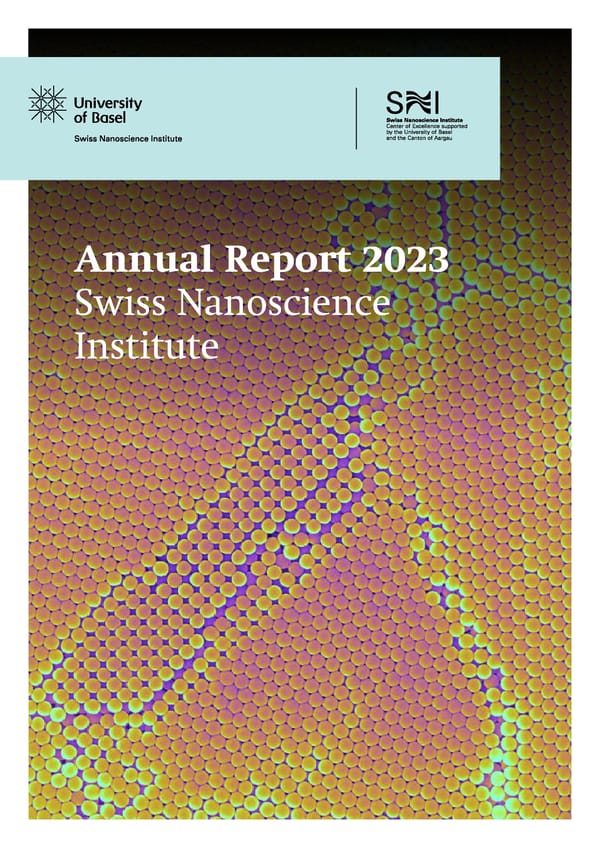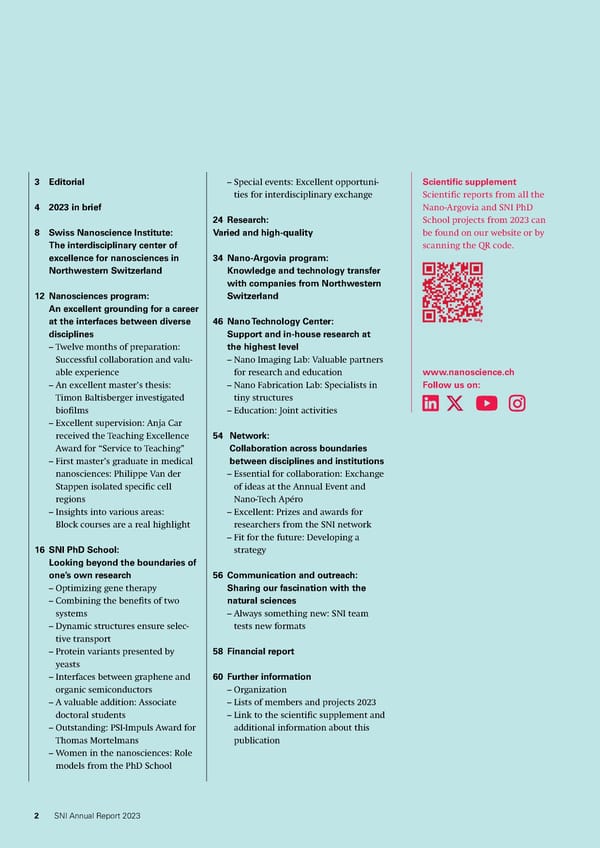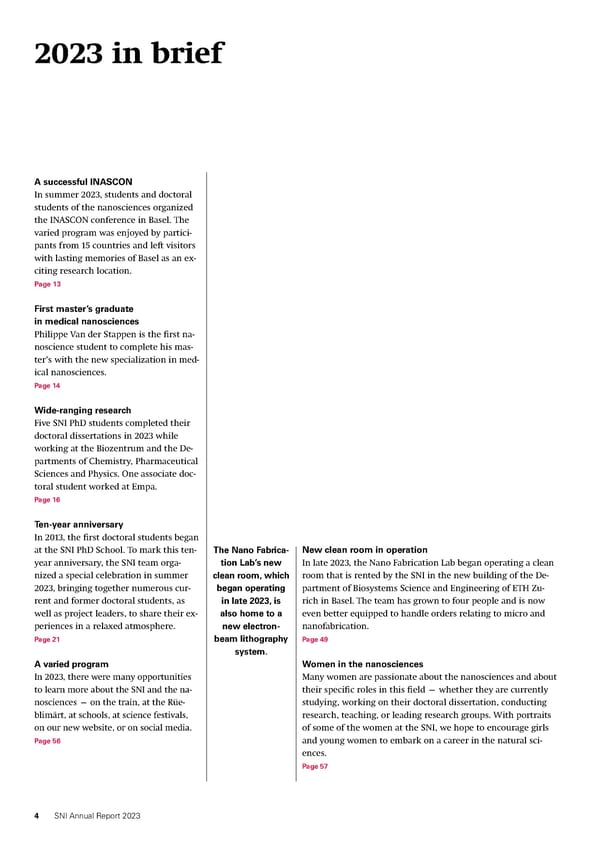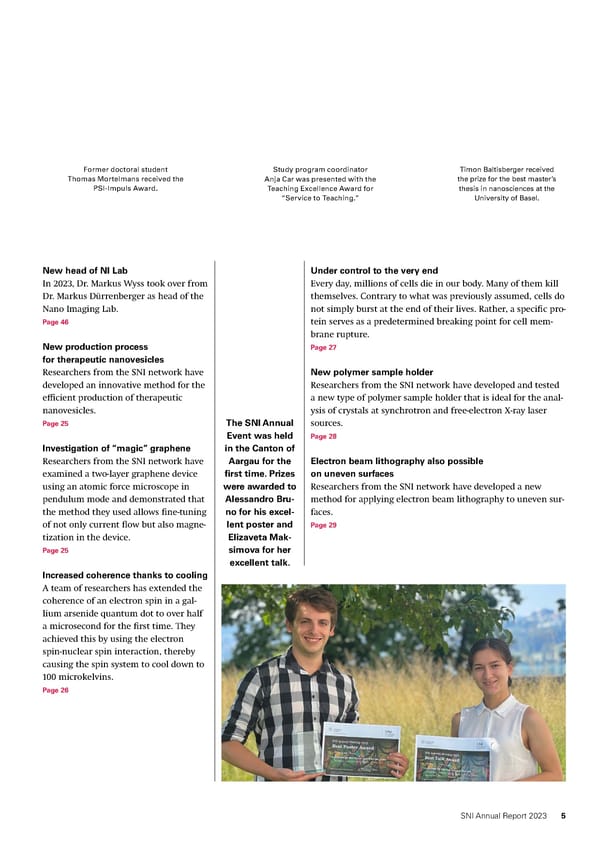Annual Report 2023
Insight into activties and results of the Swiss Nanoscience Institute in 2023
Annual Report 2023 Swiss Nanoscience Institute
3 Editorial – Special events: Excellent opportuni- Scienti昀椀c supplement ties for interdisciplinary exchange Scienti昀椀c reports from all the 4 2023 in brief Nano-Argovia and SNI PhD 24 Research: School projects from 2023 can 8 Swiss Nanoscience Institute: Varied and high-quality be found on our website or by The interdisciplinary center of scanning the QR code. excellence for nanosciences in 34 Nano-Argovia program: Northwestern Switzerland Knowledge and technology transfer with companies from Northwestern 12 Nanosciences program: Switzerland An excellent grounding for a career at the interfaces between diverse 46 Nano Technology Center: disciplines Support and in-house research at – Twelve months of preparation: the highest level Successful collaboration and valu- – Nano Imaging Lab: Valuable partners able experience for research and education www.nanoscience.ch – An excellent master’s thesis: – Nano Fabrication Lab: Specialists in Follow us on: Timon Baltisberger investigated tiny structures bio昀椀lms – Education: Joint activities – Excellent supervision: Anja Car received the Teaching Excellence 54 Network: Award for “Service to Teaching” Collaboration across boundaries – First master’s graduate in medical between disciplines and institutions nanosciences: Philippe Van der – Essential for collaboration: Exchange Stappen isolated speci昀椀c cell of ideas at the Annual Event and regions Nano-Tech Apéro – Insights into various areas: – Excellent: Prizes and awards for Block courses are a real highlight researchers from the SNI network – Fit for the future: Developing a 16 SNI PhD School: strategy Looking beyond the boundaries of one’s own research 56 Communication and outreach: – Optimizing gene therapy Sharing our fascination with the – Combining the bene昀椀ts of two natural sciences systems – Always something new: SNI team – Dynamic structures ensure selec- tests new formats tive transport – Protein variants presented by 58 Financial report yeasts – Interfaces between graphene and 60 Further information organic semiconductors – Organization – A valuable addition: Associate – Lists of members and projects 2023 doctoral students – Link to the scienti昀椀c supplement and – Outstanding: PSI-Impuls Award for additional information about this Thomas Mortelmans publication – Women in the nanosciences: Role models from the PhD School 2 SNI Annual Report 2023
Dear colleagues and nanoenthusiasts, Once again, the time has come to look Likewise, the Nano Fabrication Lab wel- fascination with the natural sciences and back over the past year as part of the An- comed two new members of sta昀昀 at the nanosciences with the general public and nual Report. This has been my 昀椀rst full end of the year and began operating a to report on research carried out at the year as Director of the SNI, and I’ve expe- clean room in the new building of the SNI. For example, we’ve been providing rienced some real highlights in my role. Department of Biosystems Science and information about the SNI via a rede- In 2023, we gave considerable thought Engineering of ETH Zurich in Basel. Ac- signed website since the start of 2023 — to the future of our unique, interdisci- cordingly, the Nano Technology Center is and we also o昀昀ered science experiments plinary network and worked on drawing even better equipped not only to assist and craft projects to interested adults, up a strategy paper. Although the paper researchers from academia and industry teenagers and children on train journeys. will only be published in spring 2024, I with surface imaging and analysis, as well Through these wide-ranging exam- can already reveal that we will be focus- as micro and nanofabrication, but also to ples, the Annual Report 2023 provides an ing on nanoimaging and nanofabrication continue expanding its services through overview of the work of SNI members and strengthening collaboration within its own research. over the last year. We hope you enjoy our network. We will adapt to changes in Research into the nanosciences is and reading it. external conditions so that we continue will remain an integral part of the SNI to contribute to solving the challenges — and we support projects in the areas Kind regards, that our society faces tomorrow through of both basic and applied science. Two our activities in the areas of research, ser- sections of the Annual Report are devoted vices and teaching. The sharper focus on to the results of research projects that our core strengths will help us to position were published by SNI members or car- the SNI and equip it for the future — not ried out by teams as part of the Nano-Ar- only with regard to research and educa- govia program in 2023. Professor Martino Poggio tion but also in terms of services, exper- Another key part of our work has al- SNI Director tise and technology transfer. ways been the training of excellent young Another highlight was undoubtedly scientists, who not only gain valuable spe- the Annual Event 2023, which saw SNI cialist knowledge but also learn to look members come together in the Canton of beyond the boundaries of their own re- Aargau for the 昀椀rst time. Events such as search. As scientists, they are therefore these are vital for our interdisciplinary ideally prepared to work at the interfaces community, providing an opportunity to between di昀昀erent disciplines. Summaries learn about each other’s work, to make of the dissertations completed at the SNI new contacts, and to come up with ideas PhD School in 2023 provide insights into for joint projects. An occasion such as this the projects supported by the SNI. is not only important from a research per- The year also brought highlights in spective — indeed, our two service units, relation to the nanosciences study pro- the Nano Imaging Lab and the Nano Fab- gram. For example, the program coordi- rication Lab, also bene昀椀t from this ex- nator, Dr. Anja Car, received the Univer- change of ideas and the opportunity to sity of Basel’s Teaching Excellence Award inform the entire network of their for “Service to Teaching” in recognition wide-ranging services. of her excellent work. Moreover, 2023 was For the two service teams, which to- the 昀椀rst year in which nanoscience stu- gether make up the Nano Technology Cen- dents completed their master’s studies ter, 2023 was a signi昀椀cant year. Following with a major in medical nanosciences. the retirement of Dr. Markus Dürren- This popular specialization has been berger, the nanoscientist Dr. Marcus Wyss available to students since 2021. took over as head of the Nano Imaging The last section of the Annual Report Lab, and a new member of sta昀昀 also joined provides examples of various activities the team, which numbers six people. that we carry out in order to share our SNI Annual Report 2023 3
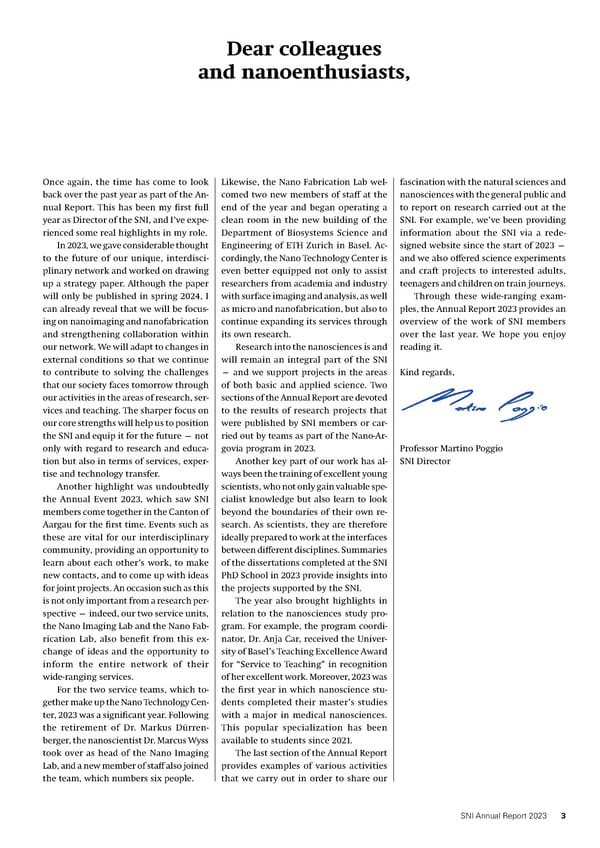
2023 in brief A successful INASCON In summer 2023, students and doctoral students of the nanosciences organized the INASCON conference in Basel. The varied program was enjoyed by partici- pants from 15 countries and left visitors with lasting memories of Basel as an ex- citing research location. Page 13 First master’s graduate in medical nanosciences Philippe Van der Stappen is the 昀椀rst na- noscience student to complete his mas- ter’s with the new specialization in med- ical nanosciences. Page 14 Wide-ranging research Five SNI PhD students completed their doctoral dissertations in 2023 while working at the Biozentrum and the De- partments of Chemistry, Pharmaceutical Sciences and Physics. One associate doc- toral student worked at Empa. Page 16 Ten-year anniversary In 2013, the 昀椀rst doctoral students began at the SNI PhD School. To mark this ten- The Nano Fabrica- New clean room in operation year anniversary, the SNI team orga- tion Lab’s new In late 2023, the Nano Fabrication Lab began operating a clean nized a special celebration in summer clean room, which room that is rented by the SNI in the new building of the De- 2023, bringing together numerous cur- began operating partment of Biosystems Science and Engineering of ETH Zu- rent and former doctoral students, as in late 2023, is rich in Basel. The team has grown to four people and is now well as project leaders, to share their ex- also home to a even better equipped to handle orders relating to micro and periences in a relaxed atmosphere. new electron- nanofabrication. Page 21 beam lithography Page 49 system. A varied program Women in the nanosciences In 2023, there were many opportunities Many women are passionate about the nanosciences and about to learn more about the SNI and the na- their speci昀椀c roles in this 昀椀eld — whether they are currently nosciences — on the train, at the Rüe- studying, working on their doctoral dissertation, conducting blimärt, at schools, at science festivals, research, teaching, or leading research groups. With portraits on our new website, or on social media. of some of the women at the SNI, we hope to encourage girls Page 56 and young women to embark on a career in the natural sci- ences. Page 57 4 SNI Annual Report 2023
Former doctoral student Study program coordinator Timon Baltisberger received Thomas Mortelmans received the Anja Car was presented with the the prize for the best master’s PSI-Impuls Award. Teaching Excellence Award for thesis in nanosciences at the “Service to Teaching.” University of Basel. New head of NI Lab Under control to the very end In 2023, Dr. Markus Wyss took over from Every day, millions of cells die in our body. Many of them kill Dr. Markus Dürrenberger as head of the themselves. Contrary to what was previously assumed, cells do Nano Imaging Lab. not simply burst at the end of their lives. Rather, a speci昀椀c pro- Page 46 tein serves as a predetermined breaking point for cell mem- brane rupture. New production process Page 27 for therapeutic nanovesicles Researchers from the SNI network have New polymer sample holder developed an innovative method for the Researchers from the SNI network have developed and tested e昀케cient production of therapeutic a new type of polymer sample holder that is ideal for the anal- nanovesicles. ysis of crystals at synchrotron and free-electron X-ray laser Page 25 The SNI Annual sources. Event was held Page 28 Investigation of “magic” graphene in the Canton of Researchers from the SNI network have Aargau for the Electron beam lithography also possible examined a two-layer graphene device 昀椀rst time. Prizes on uneven surfaces using an atomic force microscope in were awarded to Researchers from the SNI network have developed a new pendulum mode and demonstrated that Alessandro Bru- method for applying electron beam lithography to uneven sur- the method they used allows 昀椀ne-tuning no for his excel- faces. of not only current 昀氀ow but also magne- lent poster and Page 29 tization in the device. Elizaveta Mak- Page 25 simova for her excellent talk. Increased coherence thanks to cooling A team of researchers has extended the coherence of an electron spin in a gal- lium arsenide quantum dot to over half a microsecond for the 昀椀rst time. They achieved this by using the electron spin-nuclear spin interaction, thereby causing the spin system to cool down to 100 microkelvins. Page 26 SNI Annual Report 2023 5
6 SNI Annual Report 2023
From basic principles to practical applications In the SNI’s interdisciplinary research network, researchers work on questions of basic and applied science. Networking with industrial companies ensures knowledge and technology transfer, helping to solve wide-ranging challenges that our society faces. More information from page 34 onward In the Nano-Argovia project NanoHighSens, researchers from FHNW and the company Camille Bauer Metrawatt AG are working together to develop a new kind of cur- rent sensor. This is intended to surpass the bandwidth and resolution of existing technologies and to meet new standards for power quality measurement devices. (Image: J. Pascal, FHNW) SNI Annual Report 2023 7
Swiss Nanoscience Institute: The interdisciplinary center of excellence for nanosciences in Northwestern Switzerland The Swiss Nanoscience Institute (SNI) at the Uni- versity of Basel is a center of excellence for nano- sciences and nanotechnology and was founded in 2006 on the initiative of the Canton of Aargau and the University of Basel. 20% The SNI is underpinned by a network of scientists 20% of SNI members from leading research institutions in Northwestern are women. Switzerland. These researchers work on questions of basic or applied science in relation to the nano- sciences and nanotechnology. Moreover, they are involved in educating young nanoscientists who have broad interdisciplinary expertise and are ideal - 12+5+5 ly prepared to work at the interfaces between dif- ferent disciplines. In 2023, 12 students successfully completed their bachelor’s program, 5 completed the master’s program. To drive this interdisciplinary education further, the Five PhD students successfully SNI coordinates Switzerland’s unique nanoscience defended their theses. degree program at the University of Basel, which leads students to a bachelor’s and a master’s de- gree in nanosciences. The SNI also runs a PhD School, which attracts early career researchers from all over the world. Support for education and research is also provid- ed by the SNI’s Nano Technology Center, which consists of two service units: the Nano Imaging 40 Lab and the Nano Fabrication Lab. With a total of 10 members of staff, the team is available to cus- In 2023, 40 PhD students were enrolled in the SNI PhD School. tomers from higher education institutions and companies and supports their research by provid- ing services in the areas of imaging, analysis, and nano and microfabrication. 8 SNI Annual Report 2023
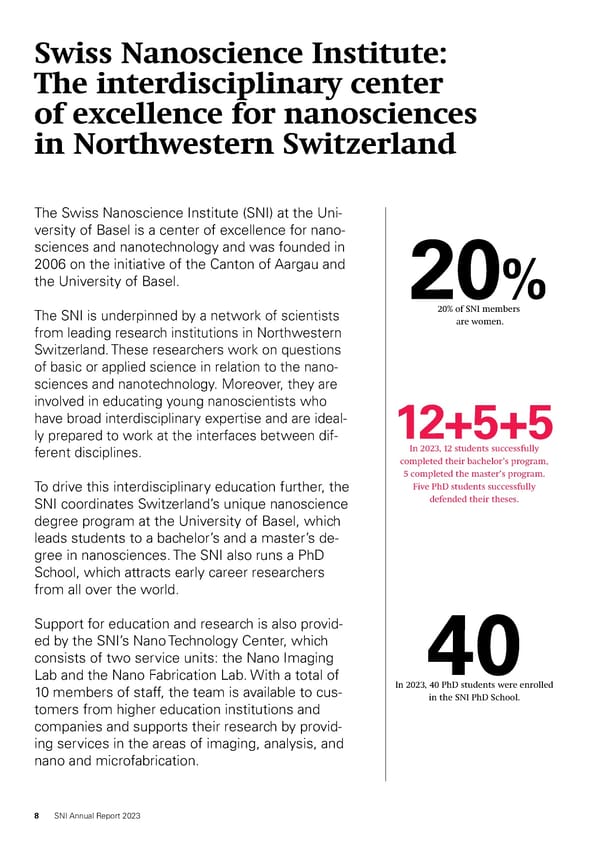
167 167 members belong to the SNI network. (PIs, PhD students, management, volun- tary members, Nano Fabrication Lab and 10 Nano Imaging Lab) There are ten partner institutions in the SNI network. These include the research institutions University of Basel, the School of Life Sciences and the School of Engineering at the University of Applied Sciences and 14 Arts Northwestern Switzerland (FHNW), Fourteen of the 53 PhD students the Paul Scherrer Institute PSI, the who had completed their PhDs by the Centre Suisse d`Electronique et de end of 2023 work at a federal or research Microtechnique (CSEM) in Allschwil, institution. the Department of Biosystems Science and Engineering at the ETH Zurich 49 in Basel, and the technology transfer The SNI supported 49 research projects, centers ANAXAM and Swiss PIC. The 9 in applied research and 40 in the SNI network also includes the Hightech PhD School. Zentrum Aargau and Basel Area Business & Innovation. 39 9 M Thirty-nine of the 53 PhD students who In 2023, the SNI had expenditures of had completed their PhDs by the end of approximately CHF 9 million (without 2023 work in industry. building costs) of which CHF 6.4 million were covered by the Canton of Aargau 82 and CHF 2.6 million by the In 2023, 56 students were enrolled on University of Basel. the bachelor’s program and 26 on the master’s program. 45 80+126 In 2023, a total of 45 peer-reviewed In 2023, 80 clients used the Nano Fabri- papers with participation of SNI cation Lab`s service. The Nano Imaging members were published in renowned Lab received more than 180 orders, science journals. >5500 which often take several days, from 126 The SNI social media channels on di昀昀erent clients. Instagram, LinkedIn, X and YouTube have more than 5,500 followers. SNI Annual Report 2023 9
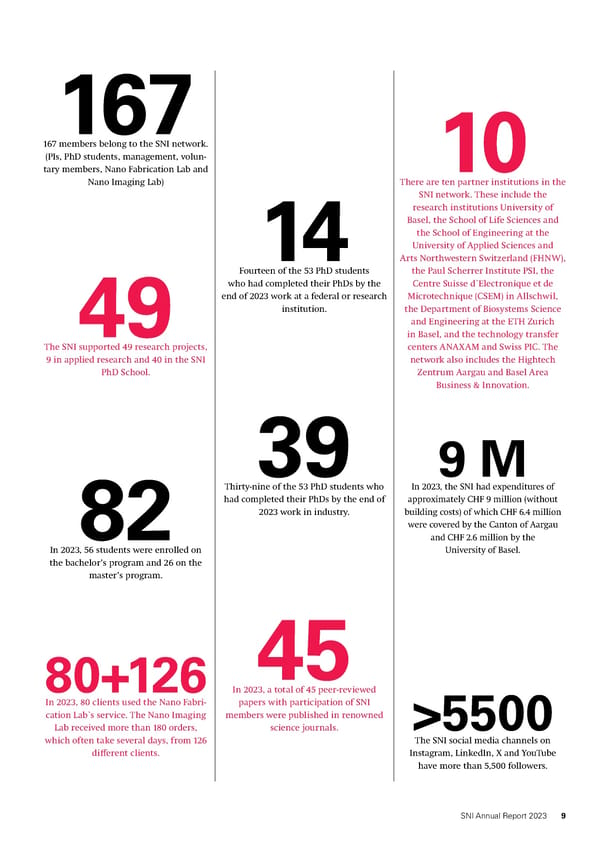
The Swiss Rooted in the Canton of Aargau and sights into applied projects in industry at an early Nanoscience the University of Basel stage in their education. Institute was The SNI was founded in 2006 by the Canton of Aargau So far, a total of 285 students have earned a bach- founded in 2006 and the University of Basel in order to drive forward elor’s degree in nanosciences in Basel, and 216 stu- on the initiative research and training in the nanosciences and nano- dents have successfully completed the master’s pro- of the Canton technology in Northwestern Switzerland. gram in nanosciences. At the end of 2023, there were of Aargau and Nanotechnologies play a key role in research and 56 students enrolled on the bachelor’s program and the University industry in the Canton of Aargau and are one of the 26 early career researchers enrolled on the master’s of Basel. focal areas of the Hightech Aargau program, with program. which the canton seeks to promote collaboration be- The next step for many nanoscience students is tween companies, higher education and research in- a doctorate — and some go on to apply for a project stitutions. Researchers from various disciplines and at the SNI PhD School, which was founded in 2012. institutions work together on numerous successful In 2023, there were 40 doctoral students working on SNI research projects, supporting the strategy in the their projects, which were largely interdisciplinary Canton of Aargau and providing companies from Aar- in nature. These students came from all over the gau, Solothurn and the two Basel half cantons with world. Five doctoral students successfully completed access to new scienti昀椀c 昀椀ndings and technologies. their dissertation in 2023, while eight new projects In 2023, the SNI spent approximately 9 million were approved and will start in 2024. Swiss francs, of which some 6.4 million were pro- Over 70% of the 53 graduates of the SNI PhD vided by the Canton of Aargau and 2.6 million by the School remain in Switzerland after completing their University of Basel. dissertation. The SNI is under- Committed members of the network pinned by its in- The Swiss Nanoscience Institute is a network of re- A key contribution to the SNI’s visibility terdisciplinary searchers from di昀昀erent disciplines who participate Basic sciences are the foundation of research work at network of in various basic scienti昀椀c or applied research proj- the SNI. As well as the various projects funded as part researchers from ects. Participating researchers come from the lead- of the PhD School, the SNI also supports basic scien- leading scienti昀椀c ing scienti昀椀c institutions of Northwestern Switzer- ti昀椀c research carried out by the two Argovia Profes- institutions in land, including the Departments of Biomedicine, sors Rodrick Lim and Martino Poggio, whose work Northwestern Chemistry, Pharmaceutical Sciences, Physics, Envi- contributes to the SNI’s outstanding reputation. Switzerland. ronmental Sciences, and the Biozentrum of the Uni- In addition, the SNI supports the research of Pro- versity of Basel, the Schools of Life Sciences and En- fessor Patrick Maletinsky, whose research group at gineering at the University of Applied Sciences the Department of Physics focuses on the develop- Northwestern Switzerland (FHNW) in Muttenz and ment and application of quantum sensors to nano- Windisch, the Paul Scherrer Institute PSI, the De- scale imaging and the investigation of advanced mag- partment of Biosystems Science and Engineering at netic materials. Outside of the University of Basel, the the Federal Institute of Technology (ETH) Zurich in SNI also supports the three titular professors Thomas Basel (D-BSSE), the CSEM (Centre Suisse d’Electro- Jung, Michel Kenzelmann and Frithjof Nolting, who nique et de Microtechnique) in Allschwil, and the lecture at the Department of Physics of the University two technology transfer centers ANAXAM and Swiss of Basel and lead active research groups at PSI. PIC. The SNI also engages in collaborations with the Hightech Zentrum Aargau in Brugg and with Basel Area Business & Innovation in relation to knowledge Exchange with industrial companies and technology transfer. The SNI supports the transfer of scienti昀椀c 昀椀ndings and technologies to industry through the Nano-Argo- via program. Since the SNI was founded, it has pro- The SNI trains Early career researchers with broad-based moted over 100 projects carried out as a collaboration excellent early knowledge between companies and research institutions from career research- The SNI’s precursor institution set up a bachelor’s Northwestern Switzerland as part of this successful ers, who are ide- and master’s program in nanosciences at the Univer- initiative. In total, nine of these applied research proj- ally suited for sity of Basel 20 years ago. Students on the bachelor’s ects were funded in 2023, with four of the partner work at the program 昀椀rst receive a solid grounding in biology, companies hailing from the Canton of Aargau, while interfaces be- chemistry, physics and mathematics and can then 昀椀ve companies are based in one of the two Basel half tween different increasingly move into a subject area that suits their cantons. Collaboration with industry is also supported disciplines. personal interests as they progress through this de- by the two technology transfer centers ANAXAM and manding program. Swiss PIC, which also form part of the SNI network. Moreover, the students have the opportunity to participate in various research groups and gain in- 10 SNI Annual Report 2023
Department of Biozentrum Chemistry Department of Department of Physics Environmental CSEM Sciences University of Basel Allschwil SNI Nano Fabrication Lab Department of Nano Imaging Lab Biomedicine Department of Pharmaceutical FHNW School of Sciences LIfe Sciences ANAXAM FHNW School of Engineering D-BSSE ETHZ Basel Paul Scherrer Institute PSI Swiss PIC The interdisciplinary network of the SNI is made up of research groups from the leading research institutions in Northwestern Switzerland. These groups work on basic scienti昀椀c and applied pro- jects and ensure an excellent standard of re- search work. (Background image: iStock) Through its two Excellent service from the Nano Educate and enthrall service units Technology Center It’s important to the SNI team not only to train young (Nano Imaging The SNI is also on hand as a service provider to part- scientists, conduct excellent research and act as a Lab and Nano ners in academia and industry. As part of the SNI sought-after partner and service provider, but also Fabrication Lab), since 2016, the Nano Imaging Lab (NI Lab) has a to inform the general public about SNI activities and the Nano Tech- six-person team and o昀昀ers comprehensive services to foster an interest in the natural sciences. nology Center relating to surface imaging and analysis. In 2022, a By taking part in science festivals, exhibitions and assists research- second service unit was added in the form of the markets, as well as through laboratory tours and new ers with surface Nano Fabrication Lab (NF Lab), which initially formats such as “MINT on the move,” the SNI sta昀昀 imaging and brought together existing activities and infrastruc- come into contact with various target groups and analysis and ture from the Department of Physics in order to o昀昀er provide them with insights into everyday laboratory micro and nano- professional and e昀昀ective services in the promising life and the nanoworld. The SNI also collates infor- fabrication. area of nanofabrication. In 2023, new equipment was mation in the form of videos, brochures, media re- purchased and a second clean room went into oper- leases and an online magazine, which reach di昀昀erent ation. target groups via various social media channels. SNI Annual Report 2023 11
Nanosciences program: An excellent grounding for a career at the interfaces between diverse disciplines Students on the nanosciences program at the University of Basel receive a broad education in the natural sciences during the intro - ductory level and then become increasingly specialized as they progress through their bachelor’s and master’s studies. In the master’s program, they can choose between specializations in medical nanosciences, molecular biology, nanochemistry and nano- physics. On top of that, however, they also bene昀椀t from an interdisci- plinary range of subjects and therefore gain insights into wide-rang- ing research questions and approaches. During their studies, the young researchers learn the “language” of the different disciplines. As specialists in their 昀椀eld, they are there- fore ideally equipped not only to lead innovative research and devel- opment for the bene昀椀t of society, but also to operate successfully at the interfaces between different disciplines. At the end of 2023, there were 56 students enrolled on the bache- lor’s program and 26 on the master’s program. Twelve students suc- cessfully completed the bachelor’s program and 昀椀ve completed their studies with a master’s degree. 12 SNI Annual Report 2023
Students of the nanosciences and doctoral students from the SNI PhD School organized INASCON 2023. Twelve months of preparation The eight-person organizing committee, consisting Successful collaboration and of students and doctoral students of the nanosciences valuable experience in Basel, had their hands full ensuring that this event turned out to be a complete success. The young re- searchers put together a fascinating program featur- In August 2023, over 60 students and doctoral stu- ing well-known speakers, took care of the 昀椀nancing, dents from 26 universities across 15 countries came promoted the event, and carried it out with great together in Basel for the International Nanoscience professionalism. For everyone involved, it was a busy Student Conference (INASCON) 2023. Since its 昀椀rst and eventful time in which they learned a great deal outing in Silkeborg (Denmark) in 2007, this nano- — and helped to ensure that those attending INA- science conference has been held in eight di昀昀erent SCON left with memories of Basel as a livable city countries. In 2023, Basel hosted the conference for and an attractive research location. the third time. Article on INASCON in SNI INSight: https://bit.ly/48vy8uE In August 2023, over 60 students and doctoral students of the nanosciences from 15 countries came together in Basel for INASCON. (Image: P. Dani) SNI Annual Report 2023 13
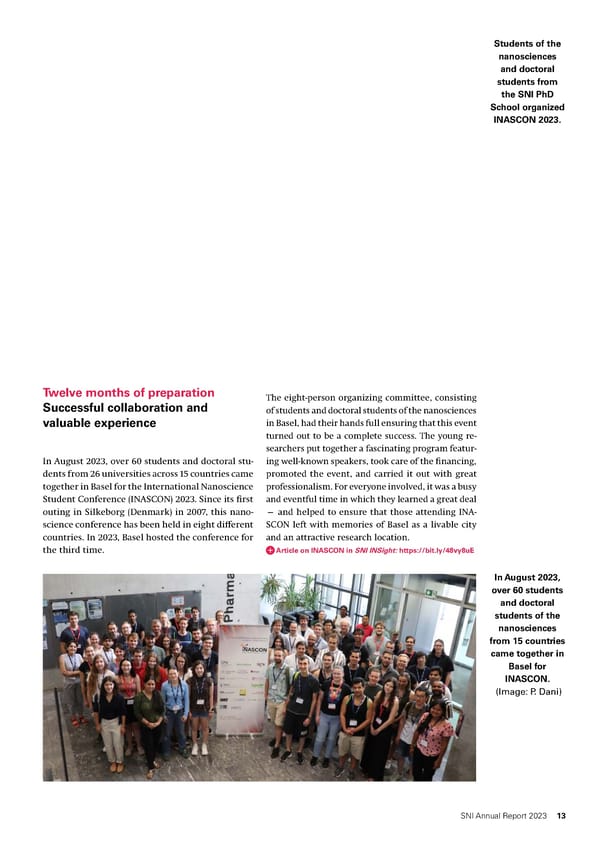
An excellent Excellent supervision First master’s graduate in master’s thesis Anja Car received the medical nanosciences Timon Baltisberger Teaching Excellence Award Philippe Van der Stappen investigated bio昀椀lms for “Service to Teaching” isolated speci昀椀c cell regions Timon Baltisberger received the prize for The nanosciences program is a challeng- Since September 2021, the option to spe- the best master’s thesis in nanosciences ing one — but time and again, students cialize in medical nanosciences has been at the University of Basel in 2023. say they value the familiar atmosphere available to nanoscience master’s stu- In his prizewinning thesis, he proved as well as the excellent supervision they dents at the University of Basel. In 2023, that Vibrio cholerae bacteria inside a bio- receive. Philippe Van der Stappen was the 昀椀rst 昀椀lm are more tolerant to various anti- The coordinator of the program, Dr. student to complete a master’s degree biotics than cultures grown in agitated Anja Car, was nominated for the Teaching with a focus on nanomedicine. liquid medium. Excellence Awards 2023 for “Service to For his master’s thesis, Van der Stap- The results help to improve our un- Teaching,” which is awarded by the Uni- pen received an Argovia Grant to work in derstanding of bio昀椀lms, which play a ma- versity of Basel, based on positive feed- Professor Alex de Marco’s group at Monash jor role in nature and can lead to stub- back from students. Anja Car was selected University (Clayton, Australia), where he born infections in humans. as the winner by deans of studies at the developed a method for isolating speci昀椀c After completing his master’s studies university and presented with the award, regions of a cell. These “subcellular re- in the nanosciences, the young researcher which stands as testament to her extraor- gions” can be used for various subsequent from the Canton of Aargau began his doc- dinary commitment to the bene昀椀t of stu- investigations — including to analyze toral dissertation at the University of Ba- dents, on 25 May, 2023. gene expression (transcriptomics) or the sel — albeit not, as one might imagine, Article on Anja Car’s career background: entire set of proteins (proteomics). on a biological/medical topic but rather https://bit.ly/3UN5MrK Article on Philippe Van der Stappen’s time in quantum physics. Once again, this Video with Anja Car: abroad: https://bit.ly/42NH3pb demonstrates how diverse an education https://youtu.be/mgfWGBSfYCg the nanoscience students receive. Article on Timon Baltisberger’s master’s thesis: https://bit.ly/3ORDA3a Video with Timon Baltisberger: “Through her tireless commit- “What makes particularly https://youtu.be/4zZjnvX-qUQ ment, Anja Car makes a vital notable about the specializa- contribution to the success of tion in medical nanoscience is the unique nanoscience degree the range of lectures covering program. As coordinator, she multiple departments that “In his master’s thesis, Timon achieves the extraordinary — provide unique insights into paved the way for investigating from both an organizational everything from molecular the effectiveness of antibiotics and a human perspective.” medicine to biocompatibility in bacterial communities.” Professor Philipp Habegger and the analysis of data from Professor Knut Drescher, Dean of Studies, imaging techniques.” Biozentrum, University of Basel Faculty of Science, Philippe Van der Stappen, University of Basel Biozentrum, University of Basel 14 SNI Annual Report 2023
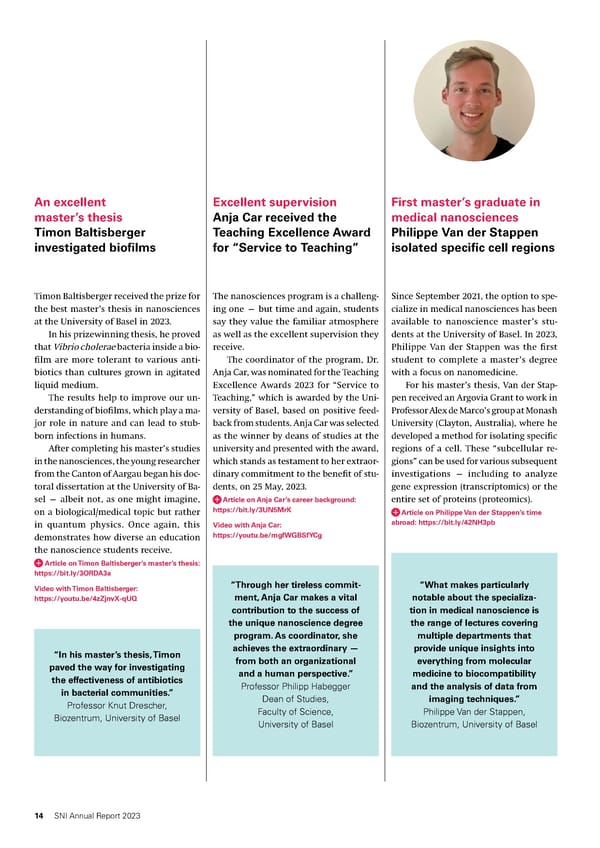
SNI Director Martino Poggio (left) with nanoscience bachelor’s graduates of 2023. Having successfully com- pleted the 昀椀rst key step in their scienti昀椀c careers, the students can now look forward to continuing their stu- dies in this fascinating 昀椀eld as part of the master’s pro- gram. (Image: A. Car) Insights into various areas Block courses are a real highlight When we ask our students about the highlights of their studies, many point to the block courses that students complete in the 昀椀fth and sixth semester of the bachelor’s program. As part of these courses, they work on their own small-scale projects in di昀昀erent research groups, gaining insights into current research topics, learning about scienti昀椀c work, and developing contacts with research groups at di昀昀erent institutions. The courses also provide another opportunity for students to identify the subjects they are particularly inter- ested in so that they can then choose the most suitable specializations in the master’s program. In 2023, students had the choice from 45 di昀昀erent block courses at various departments of the University of Basel, the FHNW School of Life Sciences, Empa, EPFL, the PSI and the Adolphe Merkle Institute. At the end of the sixth semester, the students present results from the block courses at the Small Talk conference, which is organized by the students themselves. Here, each student gives a talk to an interdisciplinary audience and presents another topic in the form of a poster. At each year’s Small Talk conference, the students present results from the block courses – and design their own 昀氀yer for the event. SNI Annual Report 2023 15
SNI PhD School: Looking beyond the boundaries of one’s own research Doctoral students at the SNI PhD School complete their dissertations in research groups at the University of Basel, the Paul Scherrer Institute, the University of Applied Sciences Northwestern Switzerland or the Depart- ment of Biosystems Science and Engineering of ETH Zurich in Basel. The students are well integrated into their working groups, where they receive excellent scienti昀椀c education with a focus on diverse subject areas. Given the interdisciplinarity of the SNI network, the doctoral students also gain insights into research projects outside of their specialist 昀椀eld — and come into contact with researchers from other disciplines at various SNI events. They receive an overview of wide-ranging projects in basic and applied science that are funded by the SNI and also learn to present their own research to an audience including people who are not experts in the 昀椀eld. This form of exchange is particularly encouraged at the annual “Nano- science in the Snow” Winter School and the Annual Event, while inter- disciplinary interactions also take place as part of courses developed speci昀椀cally for the PhD School. At the end of 2023, a total of 40 doctoral students were enrolled in the SNI PhD School, almost 30% of whom were women. Five doctoral stu- dents successfully completed their doctoral dissertations in 2023. Eight new dissertation projects were approved in 2023 and will begin in 2024. Of the 53 SNI doctoral students who have completed their dissertations so far, 74% were employed in industry at the end of 2023. In addition to that, 26% of former SNI doctoral students are employed at research or federal institutions. 16 SNI Annual Report 2023
Claudio Alter wrote his doctoral thesis at the De- David Jaeger wrote his doctoral thesis at the De- Toshiya Kozai conducted research for his doctoral partment of Pharmaceutical Sciences. He is con- partment of Physics and was employed there as a thesis at the Biozentrum and is now working tinuing his work as a postdoctoral researcher. postdoctoral researcher. there as a postdoctoral researcher. Optimizing gene therapy Combining the bene昀椀ts Dynamic structures ensure In his doctoral thesis, Dr. Claudio Alter of two systems selective transport explored various methods for e昀昀ectively In his doctoral dissertation, Dr. David Jae- In his doctoral thesis, Dr. Toshiya Kozai and safely delivering genetic material into ger developed an optomechanical plat- studied nuclear pore complexes. target cells. This research contributes to form. The resulting interaction between Nuclear pore complexes serve as se- the development of gene therapies for light and mechanical vibrations has var- lective gateways that control the ex- treating or preventing certain diseases. ious potential applications, including in change of biomolecules between the cy- Initially, Alter investigated di昀昀erent highly sensitive sensors or for the gener- toplasm and nucleus in eukaryotic cells. gene delivery strategies, including extra- ation of quantum states. These gateways consist of a cylindrical cellular vesicles, viruses, and lipid nano- The platform is based on an optical structure in the nuclear envelope with a particles (LNPs). He then enhanced the resonator, in which light is re昀氀ected back central channel of about 50 nanometers lipid composition of LNPs, incorporating and forth with the greatest possible fre- in diameter in which spaghetti-like pro- naturally occurring lipids or extracellular quency. Within this resonator, research- teins, known as disordered proteins, act vesicles — systems that facilitate gene ers position a mechanical structure that as a permeability barrier. They selectively delivery in organisms. These novel formu- can produce the vibrating motion. Thanks allow molecules “tagged” with a trans- lations substantially improved the e昀케- to the resonator, the interactions be- port factor to pass through while prevent- cacy and potency of LNPs both in vitro tween light and the mechanical element ing the entry of nonspeci昀椀c molecules. and in vivo. This improvement was pri- are intensi昀椀ed by several orders of mag- In his work, Kozai studied the perme- marily due to enhanced cellular uptake nitude. This setup can be used not only ability barrier of individual nuclear pore and processing in target cells. Further- to accurately measure the movements of complexes of wild-types and certain mu- more, he investigated the behavior and the mechanical structure, but even to tants using a high-speed atomic force mi- e昀케cacy of di昀昀erent LNP formulations in control the structure using light. croscope. This microscope can image bio- animal models. The distribution and cir- Jaeger implemented the optical cavity molecules at a resolution of a few nano- culation observed in zebra昀椀sh larvae pro- using two glass 昀椀bers with mirror-coated meters and, because of its speed, can vide valuable insights into the behavior ends. For the mechanical resonator posi- generate a 昀椀lm that reproduces the dy- of LNPs. tioned between the two 昀椀bers, he used namics of structural changes. Claudio Alter’s research has provided hexagonal boron nitride (hBN) 昀氀akes sus- The results demonstrate that the dis- a deeper understanding of LNPs, paving pended over holes in a silicon nitride ordered proteins in the central channel the way for the future development of membrane. Given the special properties exhibit dynamic fluctuations and, to- e昀昀ective and potent gene therapies based of the two-dimensional hBN, the resona- gether with various transport factors, on lipid nanoparticles. tor absorbs only a small amount of light form a highly dynamic structure. They Video: https://youtu.be/xR6OzF1z6Sg and ensures long-lasting mirroring. play a crucial role in the functionality of Media release: https://bit.ly/49GHfcf Publication: https://bit.ly/3RM2tiF the barrier and ensure a fast and adaptive Publication: https://bit.ly/3Ny0QT6 response. Publication: https://bit.ly/3S2iMXw SNI Annual Report 2023 17
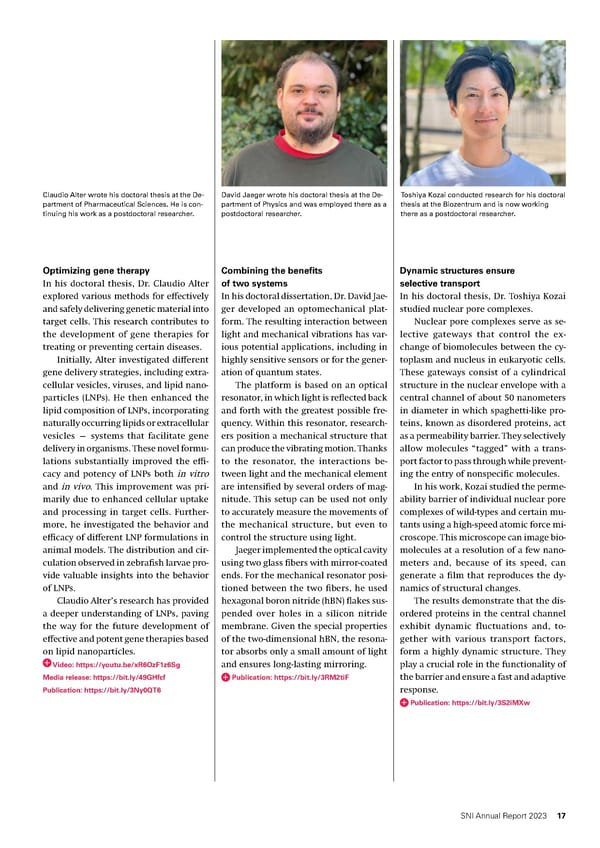
“Attending the interdisciplinary SNI PhD School enriched my perspective signi昀椀cantly, a crucial factor for addressing complex challenges in today’s technological landscape.” Dr. Jacopo Oswald, former associate doctoral student at the SNI PhD School Joanan López Morales completed his doctoral Jacopo Oswald was associate member of the SNI thesis at the Department of Chemistry at the Uni- PhD School and conducted research for his doc- versity of Basel. He is currently a postdoctoral fel- toral thesis at Empa. low at Roche. Protein variants presented by yeasts Interfaces between graphene In his doctoral thesis, Dr. Joanan López and organic semiconductors Morales further improved a valuable tool In his doctoral thesis, Dr. Jacopo Oswald for protein engineering and the directed focused on interfaces between graphene evolution of proteins, known as yeast sur- and di昀昀erent organic semiconductors. face display. The combination of the two-dimensional In yeast surface display, yeast cells are material graphene, which has special equipped with speci昀椀c genes. This allows electrical, thermal and mechanical prop- the yeast cells to form di昀昀erent versions erties, with the adaptable and versatile of a protein on the cell surface, which three-dimensional organic semiconduc- then interact and bind to other cells, pro- tors promises the development of com- teins or antibodies. The binding allows ponents for electronic devices that can an automated process to select the yeast help to overcome some intrinsic limita- cells carrying proteins of interest on their tions of traditional silicon-based devices. surface. Oswald focused on investigating the López Morales developed new systems charge transport properties of graphene/ and proteins with improved properties organic semiconductor interfaces and the using yeast surface display as a central potential for device integration. He 昀椀rst technology platform, expanding the grew graphene on copper foils and then range of applications in biotechnology, transferred the graphene layers to silicon biochemistry and clinical settings. For in- and various organic materials using the stance, he focused on developing a sero- wet transfer technique. By means of char- logical immunoassay for the detection of acterization techniques such as atomic anti-SARS-CoV-2 immunoglobulins in hu- force microscopy and Raman spectros- man sera. In another part of his disserta- copy, in combination with the electrical tion, he designed a new yeast surface dis- characterization of the interfaces, he was play system in which the copy number of able to show how organic molecules in- proteins on the yeast cells can be adjusted teract with and in昀氀uence the electronic using a genetic circuit — a long-sought properties of graphene. In doing so, he enhancement supporting its use in high- considered both the e昀昀ect of the mole- throughput screening. In addition, López cules on in-plane charge transport in the Morales designed a strategy for new bind- graphene layer and temperature-depen- ing functions and engineered a 昀椀rst-rate dent charge carrier injection across the non-antibody sca昀昀old with enhanced me- vertical heterostructures. chanical properties for immunothera- Publication: https://bit.ly/41xs4zl pies. Publication: https://bit.ly/3GR6lbV 18 SNI Annual Report 2023
For Jacopo Oswald, the member- In 2023, former SNI doctoral ship of the SNI PhD School as an student Thomas Mortelmans associate doctoral student was an received the 2023 enriching experience. PSI-Impuls Award. A valuable addition Outstanding Associate doctoral students PSI-Impuls Award for Thomas Mortelmans Doctoral students carrying out research In short videos, Annika Huber and as part of a dissertation project funded by The Paul Scherrer Institute PSI and the Antonia Ruffo talked about their research and motivation. the SNI are members of the SNI PhD PSI-Impuls Association presented former School. Particularly interested and quali- SNI doctoral student Dr. Thomas Mortel- fied doctoral students whose funding mans with the PSI-Impuls Award. Mortel- comes from other sources can also be in- mans received the prize, which is pre- Women in the nanosciences corporated as “associate doctoral stu- sented every two years for the best appli- Role models from the dents” if their supervisors are members cation-oriented doctoral dissertation at PhD School of the SNI network and request their in- the PSI, for his dissertation on a new kind clusion. of rapid COVID-19 test that can also be These associate doctoral students be- used to detect other viruses such as in- come part of the SNI network, attend 昀氀uenza A or to determine the status of By the end of 2023, two female doctoral events organized for the PhD School, and the disease. students from the SNI PhD School have bene昀椀t from interdisciplinary exchange. For his doctoral dissertation, which participated in the video series “Who are So far, two doctoral students have he began in 2018, Mortelmans worked at the women in nanoscience?,” which was taken advantage of the scheme. After Dr. the Paul Scherrer Institute. After com- launched by the SNI. Tamara Aderneuer from the CSEM, Dr. Ja- pleting the dissertation with top marks, Annika Huber from the Department copo Oswald became the 昀椀rst doctoral he swapped academia for industry and of Chemistry at the University of Basel is student from Empa to complete his doc- joined Johnson & Johnson, where is cur- working to develop a nanomaterial that toral dissertation as an associate doctoral rently working as a Device Scientist. could one day be used in a gas sensor. At student in 2023. Attending SNI courses Article: https://bit.ly/3YOrYRh the Paul Scherrer Institute, Antonia Ru昀昀o provided a valuable addition to his educa- Video on the scienti昀椀c project: is researching the development of a non- tion, and he was delighted with this added https://youtu.be/7VKskNZCoMc invasive method for measuring the tem- value. In the future, the SNI plans to fur- Video on the SNI PhD School: perature in fuel cells. ther expand the PhD School’s associate https://youtu.be/9dqX_vimmcY Having both followed their own ca- membership scheme. reer pathways, the two young women are very much enjoying their current re- search work and serve as role models for other young women with an interest in the natural sciences in general and the nanosciences in particular. Videos: Annika Huber: https://youtu.be/8JxTRe8rRPo Antonia Ruffo: https://youtu.be/V386tx4PLFA SNI Annual Report 2023 19
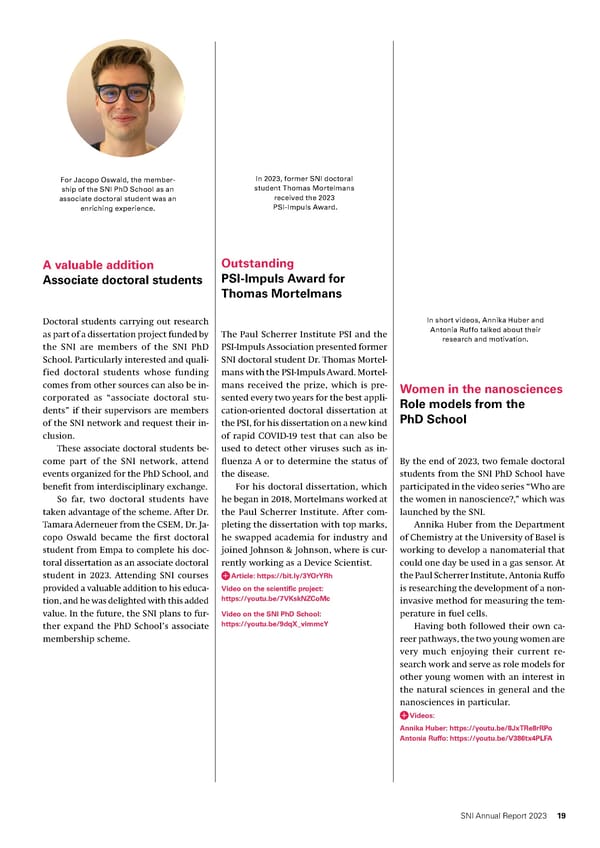
Overview of the origin of SNI doctoral students enrolled to date (in black) and the countries in which the current graduates were employed at the end of 2023 (in red). The 昀椀gures indicate the re- spective number of the nanoscientists per country. Of all 89 doctoral students enrolled to date, 33% (29 PhD students) came from Switzerland. Of the 53 graduates, 72% (38 graduates) re- mained in Switzerland after 昀椀nsihing their PhD theses. (Background image: Designed by Freepik) “The SNI Annual Event was a real highlight of the year for me. I was selected to give a talk on my results after the 昀椀rst year of my doctorate. Winning the prize for the best talk was not only unex- pected but also a great honor. The experience really boosted my self-con昀椀dence!” Elizaveta Maksimova Doctoral student from the SNI PhD School and winner of the best talk award at the Annual Event 2023 At the Annual Event 2023, Alessandro Bruno won the prize for the best poster. Elizaveta Maksimova captivated the audience with an excellent lecture and received the prize for the best talk. 20 SNI Annual Report 2023
Special events Excellent opportunities for interdisciplinary exchange “What I’ve always valued about the SNI is its cutting-edge research in wide-ranging disciplines and that this work is interlinked in a very ap- th pealing manner. With that in mind, In 2023, we celebrated the 10 anniver- dents. Likewise, the Annual Event — sary of the SNI PhD School, which pro- which was held in the Canton of Aargau I was thrilled to talk to current SNI vided another excellent opportunity for for the 昀椀rst time, at Lake Hallwil — also doctoral students and staff about an exchange of ideas between members provided an opportunity for members of their research activities at the of our network. To mark this occasion, the SNI PhD School to discuss and present anniversary celebration. For me, current doctoral students and alumni to- their research to other scientists from the however, my personal highlight gether with numerous project leaders network in the form of talks and posters. was to see former PhD colleagues and members of sta昀昀 spent a wonderful The doctoral students learn to give again and talk to them about my few hours together as they enjoyed a boat presentations such as these professionally experiences outside the world trip on the Rhine. The event was an all- as part of a course on rhetoric and com- of research.” round success and an opportunity for par- munication that they all take once as part Dr. Arne Barfuss ticipants to see how doctoral students of their studies. The course teaches them Team Leader for Product who completed their theses years ago are to present their scienti昀椀c 昀椀ndings clearly Development and Power Semiconduc- still connected with the SNI, have fond and con昀椀dently to an interdisciplinary tors, Robert Bosch GmbH memories of their time here in Basel, and audience. It is provided specially for SNI continue to maintain the relationships doctoral students by the science journalist they built. and communication expert Atlant Bieri. In January, the doctoral students who In spring 2023, the SNI team also or- “The rhetoric course with Atlant are currently carrying out research as ganized an information and networking Bieri was very informative and part of the SNI all met in Unterwasser for event for SNI doctoral students at Novar- encourages you to think about the SNI Winter School “Nanoscience in tis Pavillon. At this event, the students exactly how to communicate the Snow.” The coordinator of the SNI gained an insight into the work of various things. It’s very helpful both for PhD School, Dr. Andreas Baumgartner, Novartis employees as well as informa- presentations and for job had assembled a varied program of talks tion and tips on prospective applications interviews!” from project leaders and doctoral stu- to the global pharmaceutical company. Josh Zuber, doctoral student at the SNI PhD School As part of the SNI PhD School’s 10th anniversary celebration, current and former doctoral students together with project leaders met for an inspiring exchange of ideas on the Rhine. SNI Annual Report 2023 21
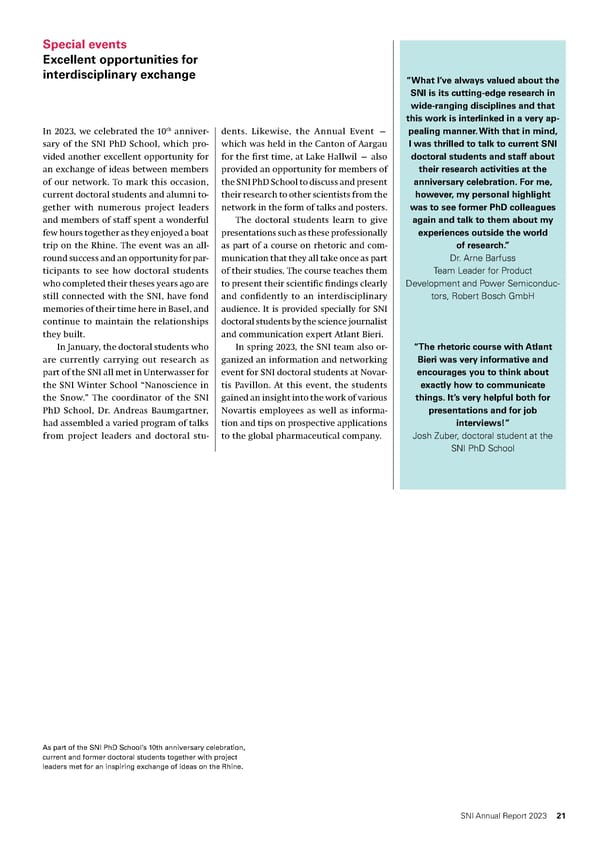
22 SNI Annual Report 2023
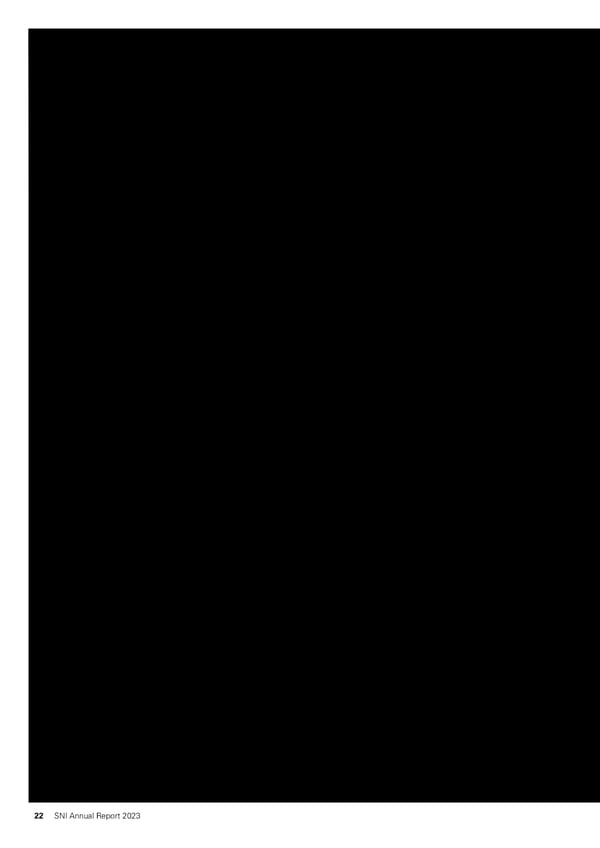
A better understanding of cell death Cells do not simply burst at the end of their lives. Rather, the protein ninjurin-1 provides breaking points for cell membrane rupture. More information on this research on page 27. (Image. M. Degen Biozentrum, University of Basel) SNI Annual Report 2023 23
Research: Varied and high-quality The basis of innovations often lies in exploring fundamental scienti昀椀c principles. Understanding how systems work is the 昀椀rst step toward potential applications. Accordingly, basic research plays a vital role at the Swiss Nanoscience Institute. A wide range of research 昀椀elds are addressed within the SNI net- work. Most projects revolve around understanding quantum physical phenomena and biomedical questions. Above all, researchers in the SNI network focus on making the nanoworld “visible” and on produc- ing nanoscale structures and materials. In 2023, researchers from the SNI network published 45 publications in respected journals. A small selection of these publications is pre- sented here to provide insights into the wide-ranging subject areas and results obtained. The various research 昀椀ndings help us learn to understand the special laws that rule the nanoworld, paving the way for various applications. 24 SNI Annual Report 2023
New production process for therapeutic nanovesicles Promising combination Researchers at the University of Basel have developed an e昀케- Researchers from the SNI network have fabricated a tiny optome- cient method for the preparation of therapeutic nanovesicles, chanical device consisting of a two-dimensional, free-hanging thereby ful昀椀lling a key prerequisite for industrial production. hexagonal boron nitride (hBN) layer suspended above holes in a The method also paves the way for research into areas such as silicon nitride membrane. The tiny hBN drum can be excited and immunotherapy treatments for cancer. then begins to vibrate, acting as a mechanical resonator. Video: https://youtu.be/xR6OzF1z6Sg SNI post: https://bit.ly/3V7ivGb Media release: https://bit.ly/49GHfcf Original publication: https://pubs.acs.org/doi/10.1021/acs.nanolett.3c00233 Original publication: https://www.nature.com/articles/s42003-023-04859-2 The new method allows an ef昀椀cient production of therapeutic nanovesicles. (Video: C. Alter, Department of Pharmaceutical Sciences, University of Basel) Investigation of “magic” graphene Researchers from the SNI network have used an atomic force microscope in pendulum mode to study a two-layer graphene device. In this bilayer graphene, the two layers of pure carbon were rotated by the “magic angle” of approximately 1.1° relative A two-dimensional boron nitride layer is suspended above holes in a silicon to one another. The results provide empirical proof that the nitride membrane. The device could be used as an optomechanical sensor. (Image: D. Jaeger, Department of Physics, University of Basel) method can be used to 昀椀ne-tune not only current 昀氀ow but also magnetization in the device. Media release: https://bit.ly/49mDcSJ Original publication: https://www.nature.com/articles/s42005-023-01441-4 Bioink for various tissues 3D-printed arti昀椀cial biological tissues can be used as models for pharmacological tests. Researchers from the SNI network have been investigating the optimal conditions for the printing process and subsequent tissue regeneration. They have now presented a new, cost-e昀昀ective hydrogel that is suitable for use as a “bioink” and can be adapted for the printing process of di昀昀erent tissue types and conditions. Original publication: https://www.mdpi.com/2313-7673/8/1/27 The two graphene layers are twisted relative to one another by the magic angle of approximately 1.1°. Depending on how many electrons a single cell is 昀椀lled with, the graphene exhibits different electrical and magnetic proper- ties. Measurements can be made using the oscillating tip of an atomic force microscope. The green surface is doped with an excess of electrons, while the red surface is underdoped. Polarized circular currents are induced by the The researchers use a hydrogel as “bioink” for heart muscle cells. (Image: F. magnetic 昀椀eld. (Illustration: Department of Physics, University of Basel) Züger, FHNW) SNI Annual Report 2023 25
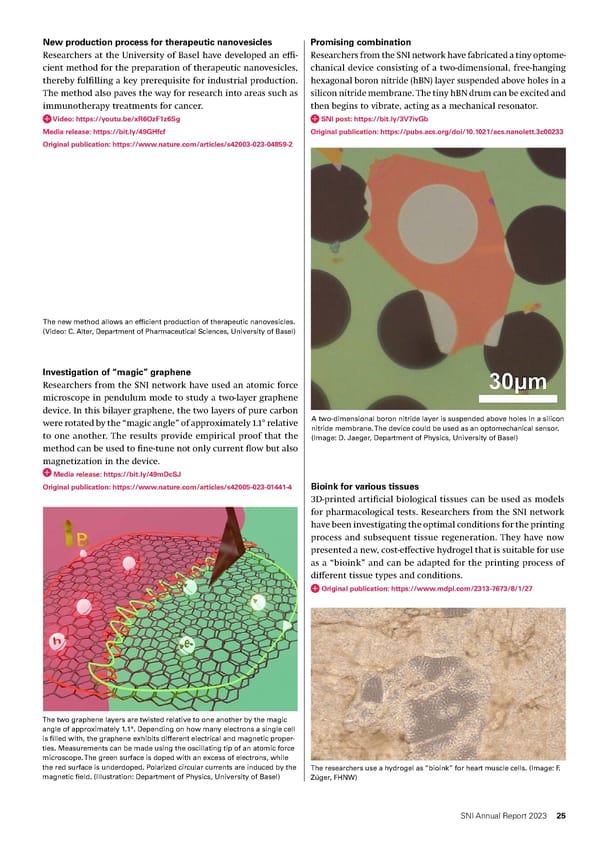
“Andreev chemistry” on a nanowire Increased coherence thanks to cooling Researchers from the SNI network and Lund University have A team of researchers from the SNI network has increased the generated superconducting pair states of electrons on several coherence of an electron spin in a gallium arsenide quantum segments of a nanowire, separated by grown barriers. Depend- dot to over half a microsecond for the 昀椀rst time. The scientists ing on the height of the barriers, these pair states can be cou- achieved the more than 150-fold increase in coherence time by pled and fused. The results provide important insights for the using the electron spin-nuclear spin interaction, which causes development of new quantum states. the spin system to cool down to 100 microkelvins. Media release: https://bit.ly/4764gor SNI post: https://bit.ly/3uwGrrC Original publication: https://www.nature.com/articles/s42005-023-01273-2 Original publication: https://journals.aps.org/prl/abstract/10.1103/PhysRev- Lett.131.210805 a) Andreev atoms: At high barriers, single, independent Andreev bound states are formed — analogous to two single hydrogen atoms. b) Andreev molecules: If the barriers between the segments are reduced, coupled Andreev bound states are formed — analogous to a hydrogen mol- ecule. c) Andreev helium: At very low barriers, the individual ABSs merge so that the pair states extend over the entire nanowire — analogous to a helium atom — and conduct electric current without dissipation. (Illustration: Department of Physics, University of Basel) By drastically reducing the 昀氀uctuations of the nuclear spins, it is possible to increase the coherence time of the electron in the quantum dot. (Image: De- partment of Physics, University of Basel) Method to improve yeast cell display Researchers from the SNI network have developed a method to improve what is known as yeast surface display — a fundamen- tal tool for protein engineering and targeted protein evolution. SNI post: https://bit.ly/3wmRq7n Original publication: https://pubs.acs.org/doi/full/10.1021/acssynbio.2c00351 Genetically modi昀椀ed cells of baker’s yeast (Saccharomyces cerevisiae) syn- thesize proteins of interest on their cell walls using yeast surface display, a tool that enhances engineering and directed evolution of proteins. (Image: © M. Oeggerli/Micronaut, supported by University Hospital Basel and the Biozentrum of the University of Basel) 26 SNI Annual Report 2023
SNI doctoral student Morris Degen is investigat- Under control to the very end – how our cells ing processes that lead to cell death at the end of kill themselves a cell’s life. Every day, millions of cells die in our body. Contrary to what was previously assumed, cells do not simply burst at the end of their lives. Rather, a speci昀椀c protein serves as a breaking point for cell membrane rupture. Researchers from the SNI network have now been able to elucidate the exact mechanism at the atomic level. Video: https://youtu.be/Smvc06udcS0 Media release: https://bit.ly/42RfwDC Original publication: https://www.nature.com/articles/s41586-023-05991-z SNI Annual Report 2023 27
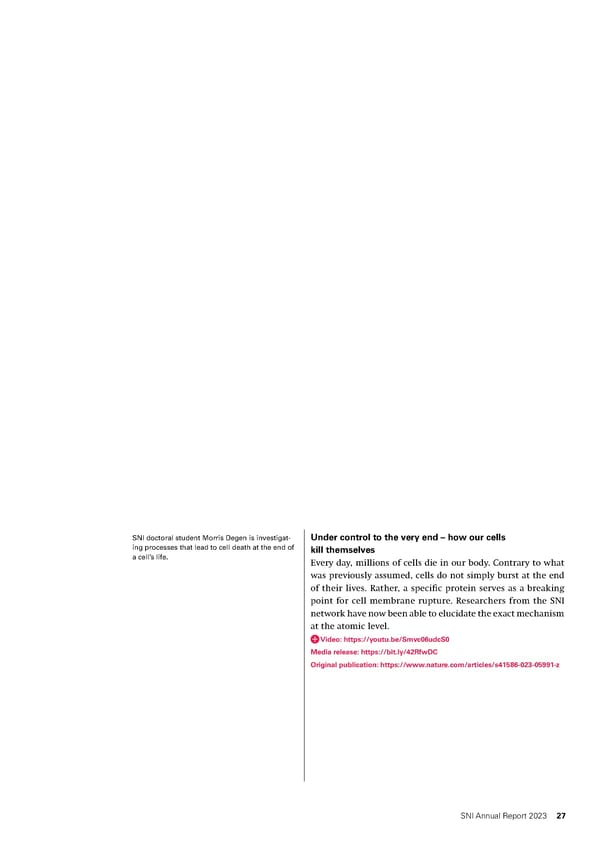
Novel polymer sample holder The polymer carrier is mounted in a sample holder. Researchers from the SNI network have developed and tested The 2 x 2 cm2 membrane contains 26,000 pyrami- a new type of polymer sample holder that is ideal for studying dal cavities. The inset shows protein microcrystals aligned within the 100 µm sized cavities (black-and- crystals at synchrotron and X-ray free-electron laser sources. white image). (Image: Paul Scherrer Institute) The crystals are applied to the transparent microstructured polymer membrane of the sample holder, allowing their posi- tion to be precisely determined prior to analysis. This work lays the foundation for developing a process for low-cost mass pro- duction of the sample holder. Original publication: https://journals.iucr.org/m/issues/2023/06/00/ zf5021/ 28 SNI Annual Report 2023
Electron beam lithography also possible Vibrations of molecules visualized and studied on uneven surfaces Researchers from the SNI network have developed a new Researchers from the SNI network have developed a new method for imaging the vibration of molecules. The scientists method for applying electron beam lithography to uneven sur- studied a speci昀椀c pyrene molecule on a silver surface using a faces. They are working with a 昀氀oating resist that enables uni- scanning tunneling microscope (STM). Understanding molecu- form coating. This method will help the researchers place elec- lar vibration is of crucial importance in a wide range of areas trical contacts on the tip of an atomic force microscope canti- in molecular electronics and spintronics and in the develop- lever and thus produce highly sensitive probes for studying ment of quantum computers, for example, since vibrations af- electric and magnetic 昀椀elds. fect transport properties and spin dynamics. Video: https://youtu.be/UBcYtnmA9Hc SNI post: https://bit.ly/3UPtBzf SNI post: https://bit.ly/42RgtMc Original publication: https://www.nature.com/articles/s41467-023-41601-2 Original publication: https://doi.org/10.1063/5.0127665 The developed method will help the researchers place electrical contacts on the tip of an atomic force microscope cantilever and thus produce highly sensitive probes for studying electric and magnetic 昀椀elds. Better classi昀椀cation with machine learning Researchers from the SNI network have presented a new ma- chine learning technique speci昀椀cally designed to enhance the analysis of protein unfolding using atomic force microscopy (AFM) data. The method is characterized by the fact that the program used repeatedly analyzes the data and thereby allows more precise and e昀케cient data classi昀椀cation. SNI post: https://bit.ly/3UQ4QTA Original publication: https://pubs.acs.org/doi/10.1021/acs.nanolett.3c03026 TBTAP molecules on a silver surface are initially negatively charged. If a positive voltage is applied to the tip of an STM and this is then brought close to the molecule, the molecule discharges. This discharge does not oc- cur in one go, but rather in an oscillating manner. (Animation: Department of Physics, University of Basel) Machine learning enhances the classi昀椀cation of unfolding patterns in pro- teins. (Image: V. Dof昀椀ni, Department of Chemistry, University of Basel) SNI Annual Report 2023 29
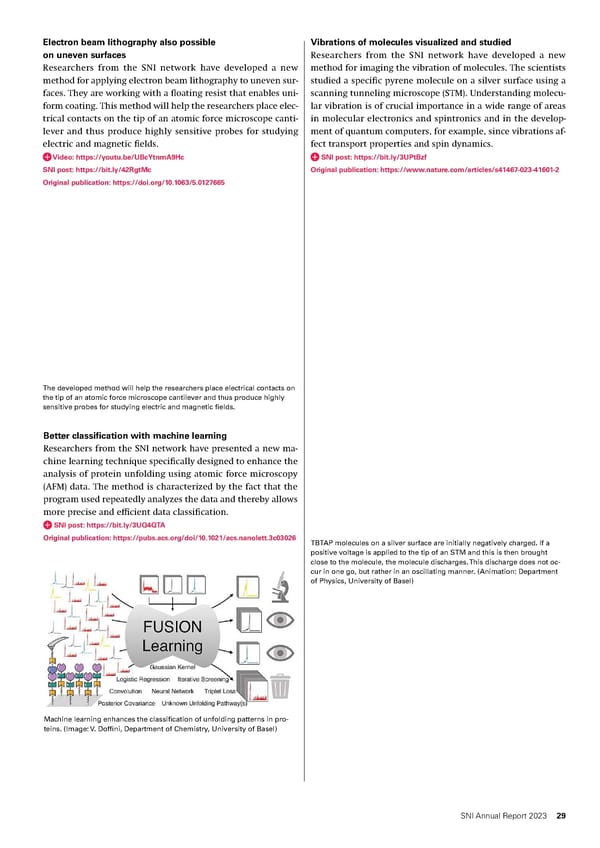
Photons survive dif昀椀cult conditions The researchers cooled the circuit board with a SNI physicists have investigated whether and how long micro- semiconductor sample (chip in the center) to mil- wave photons survive under adverse conditions. They found li-Kelvin temperatures in order to investigate the properties of the photon storage devices. (Image: that special photon memories can be produced with su昀케cient J. Ungerer, Department of Physics, University of quality even in close proximity to oxides, which are widely used Basel) in semiconductor technology. The photon memories, known as resonators, can therefore be used as sensors for quantum e昀昀ects in semiconductor structures. Original publication: https://doi.org/10.1140/epjqt/s40507-023-00199-6 30 SNI Annual Report 2023
Candidate for quantum sensing under extreme conditions Arti昀椀cial cells made from polymer and biomolecule Researchers from the SNI network have presented a robust and building blocks scalable approach to using negatively charged silicon-vacancy Arti昀椀cial organelles and cells built from a multitude of synthetic (SiV) centers in diamond nanostructures. These vacancy centers, building blocks in combination with biomolecules serve as tools in which a silicon atom is placed between two vacancies in the for gaining a better understanding of fundamental biological diamond lattice, are promising candidates for quantum sensing processes and open up new ways of producing multifunctional based on single electron spins at very low temperatures and in systems. Researchers from the SNI network describe arti昀椀cial strong magnetic 昀椀elds. compartments of this kind whose sca昀昀old consists mainly of Original publication: https://pubs.acs.org/doi/10.1021/acs.nano- polymers. Polymers are of particular interest due to their chem- lett.3c03145 ical diversity and the possibility of adjusting the properties of their assemblies such to allow biomolecules to preserve their integrity and activity when inserted/encapsulated inside. The researchers apply such advanced compartments to provide a controlled and con昀椀ned space for high throughput screening of bacteria and evaluate the e昀케cacy of antibiotics. Original publications: https://onlinelibrary.wiley.com/doi/epdf/10.1002/ advs.202305837 https://onlinelibrary.wiley.com/doi/full/10.1002/advs.202307103 Researchers are investigating the effectiveness of antibiotics against bacte- The researchers embed near-surface silicon vacancy centers in diamond na- ria that are trapped in a polymer vesicle. (Image: Reproduced under terms nopillars. (Image: J. Zuber, Department of Physics, University of Basel) of the CC-BY 4.0 license. Copyright 2023 Advanced Science published by Wi- ley-VCH GmbH) Method for measuring charge in quantum dots Researchers from the SNI network have presented an approach to studying the charge con昀椀guration of quantum dots formed in germanium nanowires with a silicon cladding. For this, they use a special superconducting resonator based on niobium-ti- tanium nitride and couple it with a double quantum dot in the germanium-silicon nanowire. Original publication: https://iopscience.iop.org/article/10.1088/2633-4356/ ace2a6 SNI Annual Report 2023 31
32 SNI Annual Report 2023
Innovation through collaboration As part of the Nano-Argovia program of the SNI, interdisciplinary teams from research institutions work closely with industrial partners from Northwestern Switzerland. Networking with companies ensures knowledge and technology transfer, helping to solve wide-ranging challenges facing society. More information from page 34 onward Several projects supported by the SNI have contributed to the development of the cryoWriter, which enables the ef昀椀cient preparation of biological samples for cryo-electron microscopy. In collaboration with the start-up cryoWrite, the researchers are testing new modules to increase the functionality. More information on page 41 SNI Annual Report 2023 33
Nano-Argovia program: Knowledge and technology transfer with companies from Northwestern Switzerland Constant exchange between academic institutions and industry is a vi- tal part of promoting innovation at companies. The SNI supports this process of knowledge and technology transfer through its Nano-Argovia program, which has existed since the SNI was founded. This successful program has enabled the SNI to support over 100 projects so far with companies from Northwestern Switzerland, paving the way for numer - ous nanotechnology applications. In 2023, nine projects were funded as part of the Nano-Argovia pro- gram — 昀椀ve new ones and four that had begun in 2022. Four of the industrial partners were from the Canton of Aargau, 昀椀ve hailing from one of the two Basel half-cantons. Participating as academic partners in 2023 were mainly the University of Applied Sciences and Arts North- western Switzerland in Muttenz and Windisch and the Paul Scherrer Institute. Likewise, colleagues from CSEM Allschwil, the University of Basel and the ANAXAM Technology Transfer Center also contributed their expertise to the success of Nano-Argovia projects. 34 SNI Annual Report 2023
Example of a half capillary — a pointed funnel Smooth mirrors for X-rays structure with a concave (hollow) design. (Image: In the Nano-Argovia project CAPOFOX, an interdisciplinary team PSI) has been working on the further development of lithographic methods for the production of micro-optical components made from polymers. These so-called capillary optics are elongated, cylindrical mirrors that focus light on a point by re昀氀ection. As they are intended to be suitable for both ultraviolet and X-rays, the mirrors must have a very low surface roughness. The researchers combined tool-, laser-, design- and materi- al-related aspects in order to develop a method that leads to an elongated three-dimensional structure of the polymers. They initially concentrated on the production of stepless, semi-cylin- drical indentations and on developing the basis for measuring nanoroughness using various methods. Cooperation with: XRnanotech // Paul Scherrer Institute // FHNW School of Life Sciences Project description: https://bit.ly/3ThvoMr “The CAPOFOX project brings together outstanding expertise in the preparation and examination of ultrasmooth surfaces. The chosen methodology is innovative and is also remarkable due to its numerous high-impact future applications. We’re very much looking forward to accompanying and supporting these developments.” Dr. Florian Döring, CEO and founder of XRnanotech SNI Annual Report 2023 35
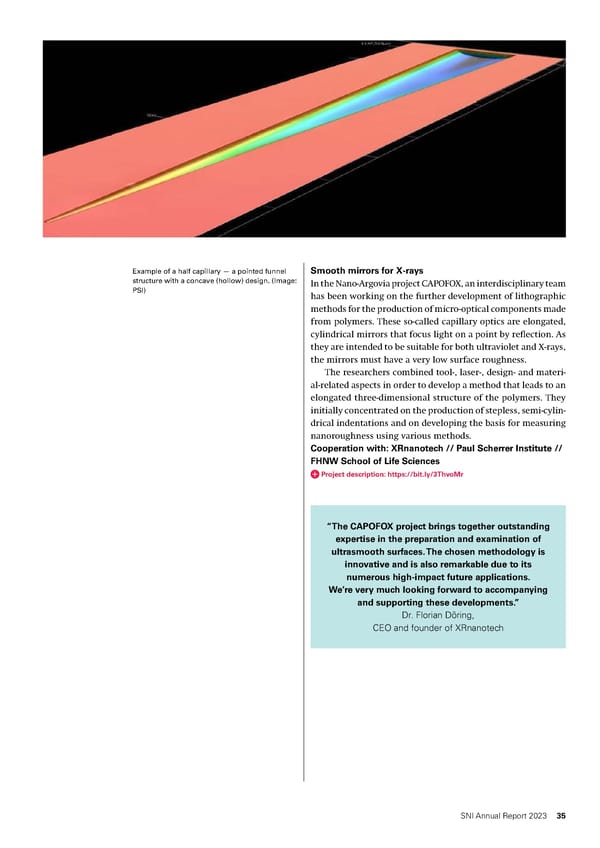
Ef昀椀cient femtosecond laser as optical tweezer Maurizio Gullo and Bojan Resan are working on the optical tweezer setup and the new red diode for 3D printing of cells pumped alexandrite laser. (Image: FHNW Windisch) In the Nano-Argovia project NanoFemto Tweezers, researchers have started to develop optical tweezers that can be used to assemble di昀昀erent cell types, including neurons, in a tiny area. The interdisciplinary team is using femtosecond lasers and na- no-optical elements to build these optical traps (tweezers). “The Nano-Argovia project They plan to use a 3D printer to build organ systems from NanoFemto Tweezers allows us di昀昀erent cell types on a micrometer surface (body-on-chip) — to investigate and commercial- for example, to be able to study the e昀昀ects of drugs on di昀昀erent ize one of our novel lasers for organ systems on a chip. multiple new applications — Cooperation with: TLD Photonics AG // FHNW School of optical tweezers, multiphoton Engineering // FHNW School of Life Sciences imaging and micro-scale 3D Project description: https://bit.ly/3I6gAKd printing of biomedical tissues.” Stephan von Wolff, CEO, TLD Photonics AG 36 SNI Annual Report 2023
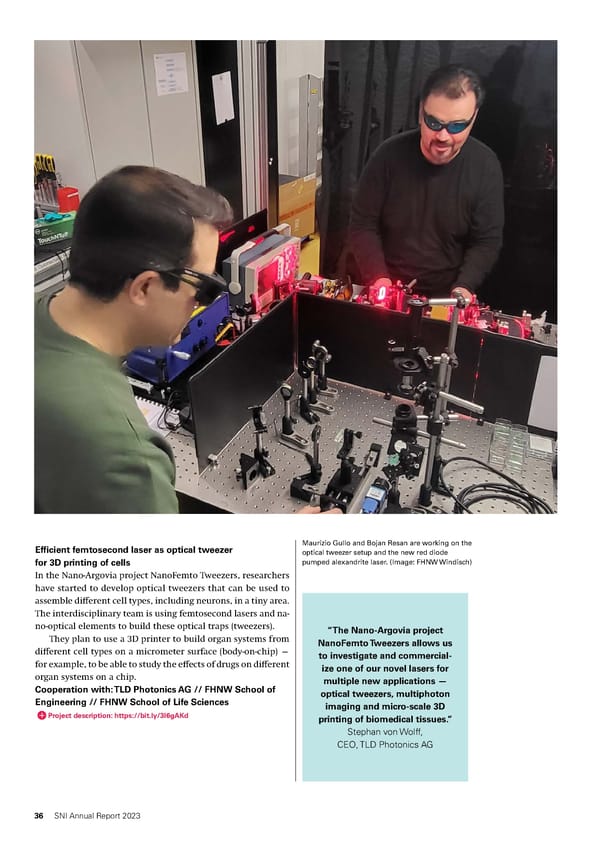
In the Nano-Argovia project NanoHighSens, re- Novel current sensor ful昀椀lling the latest quality standards searchers have started to develop a novel current In the Nano-Argovia project NanoHighSens, researchers have sensor. The researchers are using an array of started to develop a novel current sensor that aims to outper- eight small magnetometers positioned around the current conductor, each based on 100 mag- form existing technologies in terms of bandwidth and resolu- netic tunnel junctions. (Image: FHNW Muttenz) tion and is expected to meet new standards for power quality measurement devices. The researchers are using an array of eight small magneto- meters positioned around the current conductor, each based “The NanoHighSens project is on 100 magnetic tunnel junctions (MTJs). These are arranged an essential basic building over an area of 100 μm x 100 μm. The good resolution with an block for a holistic energy improved signal-to-noise ratio compared with conventional de- ef昀椀ciency assessment taking vices results from the fact that the respective measurements into account the power are based on an average of 100 magnetic 昀椀eld measurements. quality footprint.” In the 昀椀rst year of the project, the interdisciplinary team tested Max Ulrich, various magnetic tunnel junctions as well as di昀昀erent ap- Managing Director, Camille Bauer proaches to the design of the new current probe architectures. Metrawatt AG Cooperation with: Camille Bauer Metrawatt AG // FHNW School of Life Sciences // FHNW School of Engineering Project description: https://bit.ly/48ru0uQ SNI Annual Report 2023 37
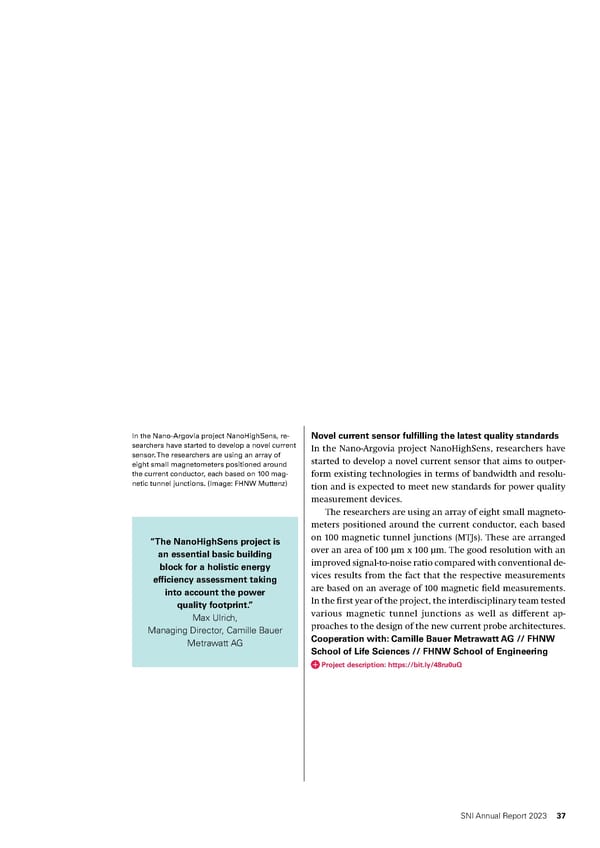
Quantum sensor for diagnostics in the brain In the Nano-Argovia project QSBI, researchers In the Nano-Argovia project QSBI, an interdisciplinary research plan to use nitrogen vacancy centers in dia- team has started to investigate the use of quantum sensors monds to optimize magnetic encephalography. (Image: PSI) based on nitrogen-vacancy (NV) centers in diamonds to study brain activity. The NV centers can be used to detect the weak magnetic 昀椀elds of the brain. The team plans to use the project to optimize the existing method of magnetoencephalography and to develop an algorithm so that a three-dimensional map “We believe that due to of brain activity can be created from the measurement data. their combination of robust The researchers are in the process of improving the signal- operation, easy logistics and to-noise ratio of the signals generated by the NV centers by high sensitivity, NV diamond applying a nanopattern of photonic crystals on the diamond magnetometers will surface. They have also started to develop machine learning revolutionize biomagnetism.” algorithms that can process the data and eventually lead to the Dr. Tobias Sjölander, reconstruction of a 3D brain activity map with high accuracy Quantum Engineer at Qnami AG and robustness. Cooperation with: Qnami AG // Paul Scherrer Institute // CSEM Allschwil Project description: https://bit.ly/47BuEFD 38 SNI Annual Report 2023
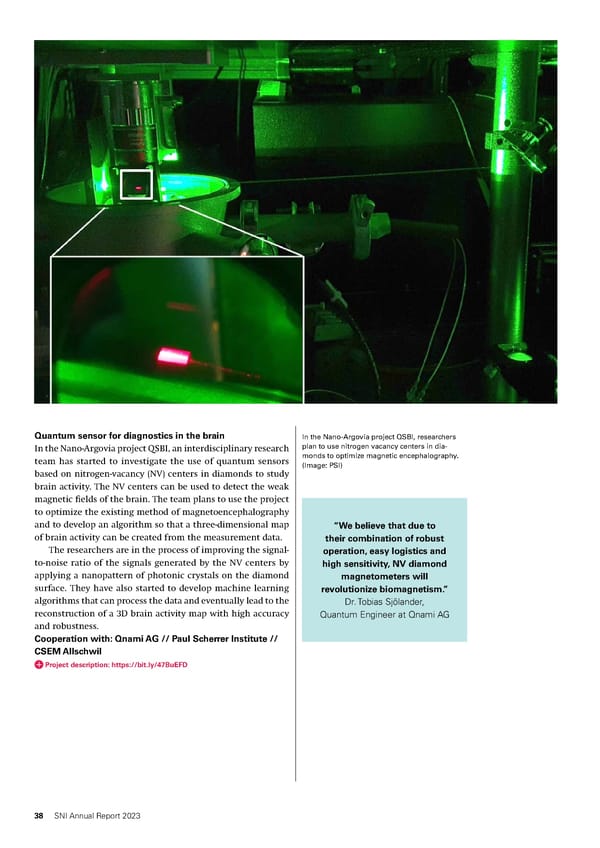
Researchers in the SmartCoat project are using Innovative approach to the treatment of cancer innovative nanoparticles to transport small In the Nano-Argovia project SmartCoat, researchers have interfering RNA into cancer cells. started to investigate a novel method for shuttling RNA-based therapeutics speci昀椀cally to tumor cells in order to downregu- late speci昀椀c genes that drive proliferation and malignancies in cancer. They are using innovative nanoparticles (SmartCoats) “The ongoing project with to transport small interfering RNA (siRNA) that can knock out FHNW and PSI is a cornerstone speci昀椀c genes. RNA interference is a natural process through of the innovation of which a disease-causing gene can be eliminated in a highly spe- Palto Therapeutics.” ci昀椀c manner. This mechanism enables precise and personalized Dr. William L. Wishart, treatment of various life-threatening diseases, including cancer. Director, Palto Therapeutics Inc. The SmartCoats protect the siRNA from enzymatic degradation and from interactions with immune cells during circulation in the body. Their speci昀椀c design also ensures that the siRNA is taken up only by targeted cancer cells. These can- cer cells have speci昀椀c structures (shuttling receptors) on their surface that enable binding and subsequent uptake of the SmartCoat-siRNA complexes into the cell. In this way, the RNA fragments only enter the degenerated cells and can exert their regulatory e昀昀ect there. Cooperation with: Palto Therapeutics AG // FHNW School of Life Sciences // Paul Scherrer Institute Project description: https://bit.ly/4bR9s1Z SNI Annual Report 2023 39
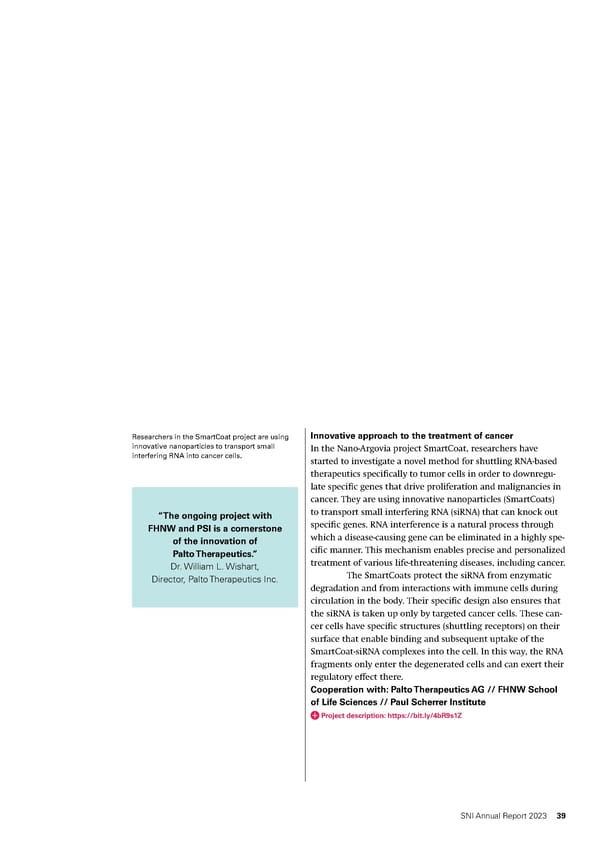
New approach to combating cancer Researchers in the Nano-Argovia project B7H3 In the Nano-Argovia project B7H3 Nanobody PC, researchers Nanobody PC are using cell cultures to investiga- have come closer to their goal of developing a new method for te a new method for imaging and treating malig- nant tumors. imaging and treating malignant tumors. The approach is based on the use of a so-called nanobody-polymer conjugate. This is a combination of a cell-speci昀椀c nanobody, which acts very sim- ilarly to antibodies but is much smaller and which binds spe- ci昀椀cally to certain cancer cells, and a polymer that can be loaded “Even though there is still a with di昀昀erent compounds. The nanobody-polymer conjugate long way to go: I am positive will be designed to cross the blood-brain barrier and then bind about the results regarding to the speci昀椀c target molecule on the surface of cells of malig- nanobody production and nant brain tumors. Depending on the active substance that is radioactive labeling, and we are bound to the nanobody-polymer conjugate, cancer cells in the looking forward to the 昀椀rst brain may be combated or imaged. A radioactively labeled na- coupling attempts with the nobody is currently in initial cell culture trials, and various test new polymer carriers.” polymers for conjugation have been developed. Dr. Christian Geraths, Cooperation with: CIS Pharma AG // FHNW School of Life CSO at CIS Pharma AG Science // Paul Scherrer Institute // University Children’s Hospital Zurich (without funding from the SNI) Project description: https://bit.ly/3lrxFGd 40 SNI Annual Report 2023
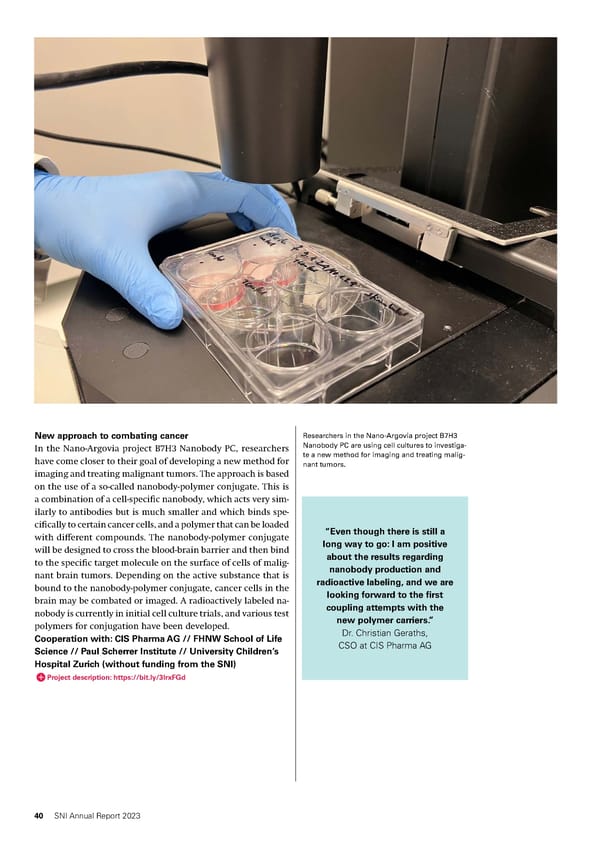
Andri Fränkl from Thomas Braun’s laboratory Imaging before shock freezing looks at shock-frozen cells that have been pre- In the Nano-Argovia project FuncEM, researchers are developing pared on a grid for electron microscopy using an extension module to the cryoWriter. The cryoWriter 昀氀ash- the cryoWriter system. freezes tiny quantities of samples — with no loss of material and in a fully automated process — before the samples are examined using cryo-electron microscopy. The planned exten- sion module should enable the researchers to analyze the “liv- “The Nano-Argovia program ing” samples immediately before the freezing process. With the offers companies in help of the optics developed so far, the interdisciplinary team Northwestern Switzerland a has succeeded in creating 3D structures of the samples, which unique opportunity to evaluate provide important information about sensitive parts of the com- the latest technologies with plex protein architecture. The researchers initially focused on experts from the academic the investigation of thin cilia, which also play a crucial role in environment. This is precisely numerous diseases. The upstream light microscopic examina- in the area between fundamen- tion provides relevant information about the functionality of tal research and product the cilia examined. development, where the know- Cooperation with: cryoWrite // Biozentrum, University of how is often not (yet) available Basel // Paul Scherrer Institute in a company. Project description: https://bit.ly/3K62L0A Dr. Patrick Frederix, CEO, cryoWrite SNI Annual Report 2023 41
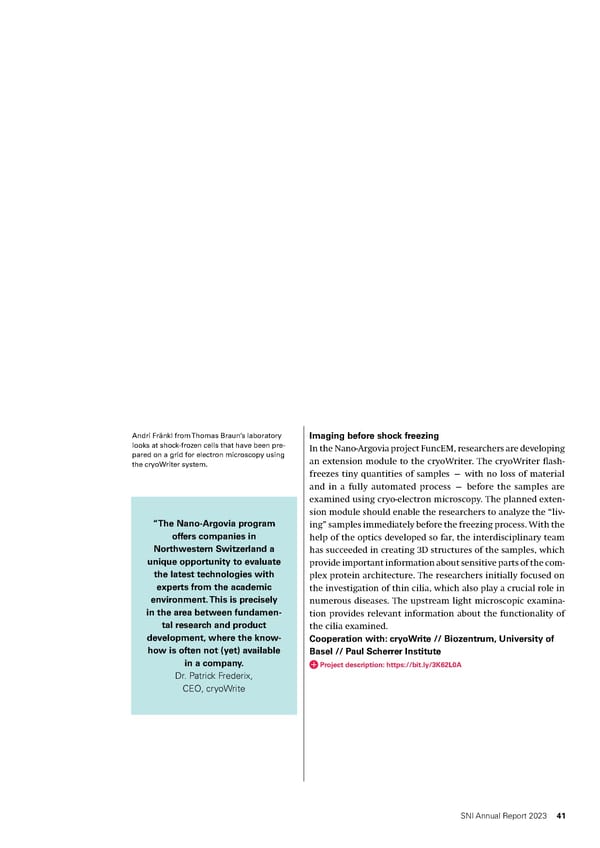
On the way to more robust power semiconductors Altered phases In the Nano-Argovia project CRONOS, an interdisciplinary team In the Nano-Argovia project META-DISPLAYS, researchers have of scientists has investigated how cosmic radiation a昀昀ects power been developing a phase retarder that can be used as a compo- semiconductors designed for high electrical currents and volt- nent in foldable and rollable screens to speci昀椀cally alter and ages. The researchers irradiated the power semiconductors with control the propagation of light. This is possible thanks to tiny protons and neutrons in a controlled manner while simultane- nanostructures on the phase retarder’s surface that change the ously applying an electrical voltage. They then carried out stress phases of the electromagnetic 昀椀eld emitted by the light source. tests focusing on speci昀椀c very thin layers in the semiconductors The researchers have now been able to reduce the retarder’s (gate oxide layers) that prevent electrical leakage currents. The thickness, making it suitable for foldable and rollable screens. researchers gained important information about the damage They also succeeded in meeting other requirements such as that physical processes can cause. Their data will support the high transmission and color neutrality. development of more robust power semiconductors. Cooperation with: Rolic Technologies Ltd // CSEM Allschwil Cooperation with: SwissSEM GmbH // FHNW School of // Paul Scherrer Institute Engineering // ANAXAM Project description: https://bit.ly/3Xw9YtE Project description: https://bit.ly/3xfcxpv In the Nano-Argovia project CRONOS, an interdisciplinary team of scientists has investigated how cosmic radiation affects power semiconductors. (Im- age: FHNW Windisch) “The Nano-Argovia project CRONOS creates ideal conditions for advancing and improving the development of power semiconductors in In the future, greater use will be made of 昀氀exible screens. (Image: Rolic Tech- collaboration with experts in material analysis.“ nologies) Dr. Roger Stark, Head of Test Laboratory, SwissSEM Technologies AG “A metasurface device will allow Rolic to strengthen its competitive advantage as a material supplier to the display industry.” Dr. Richard Frantz, Head of Development, Rolic Technologies Ltd 42 SNI Annual Report 2023
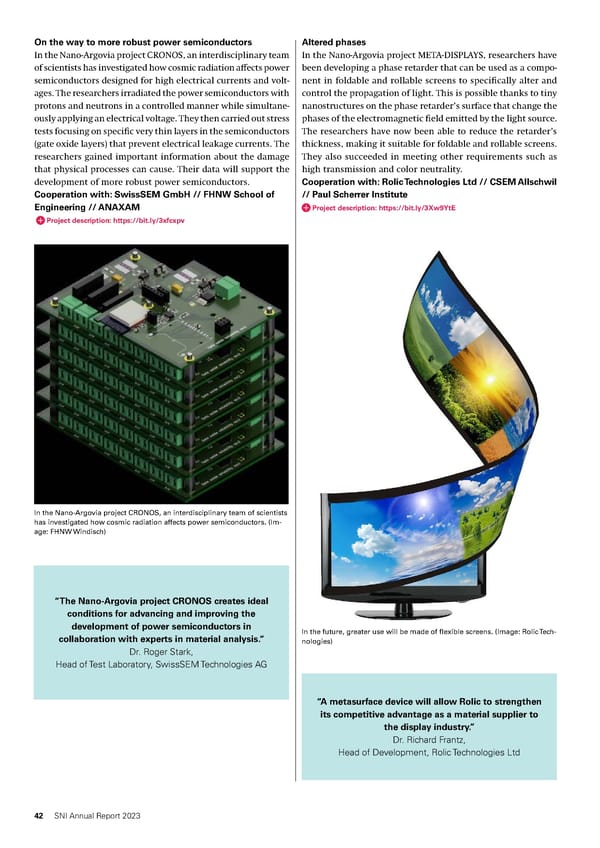
The Nano-Argovia program supports interdisciplinary applied research projects in collaboration with industrial companies from Northwestern Switzerland. Here, an employee of the FHNW School of Life Sciences is investigating the use of cer- tain nanoparticles in the 昀椀ght against cancer. SNI Annual Report 2023 43
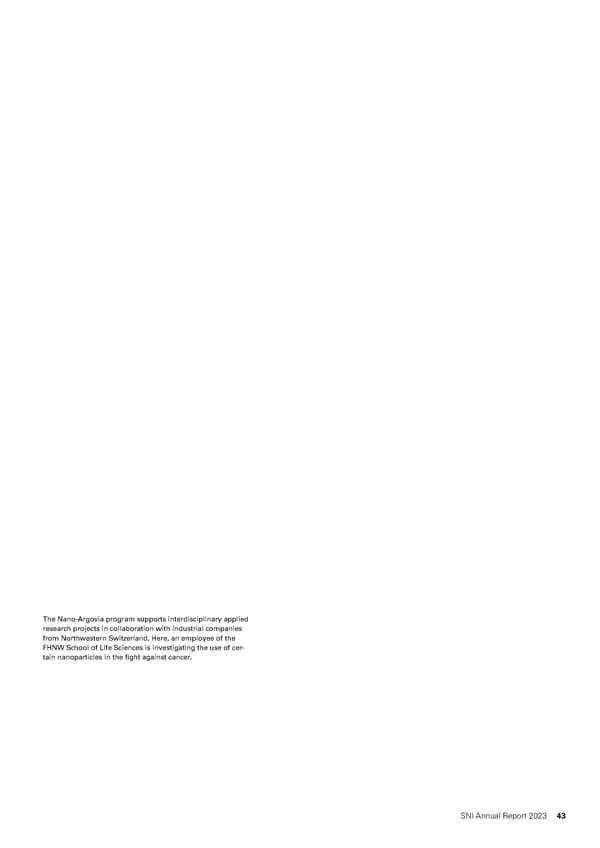
Valued support Employees of the Nano Technology Center support scienti昀椀c projects and conduct research themselves. They are also involved in helping students with their Matura theses. For example, the Nano Imaging Lab team made it possible to study insect wings using scanning electron microscopy. In addition to the Nano Imaging Lab, the Nano Fabri- cation Lab, which was founded in 2022, is also part of the SNI`s Nano Technology Center. The two service units provide comprehensive services for cus- tomers from industry and academia in the 昀椀eld of imaging, processing and analyzing surfaces as well as micro- and nanofabrication. (Image: NI Lab, SNI, University of Basel) 44 SNI Annual Report 2023
SNI Annual Report 2023 45
Nano Technology Center: Support and in-house research at the highest level After its founding in 2022, the Nano Technology Center went on to make valuable contributions to research and education in the SNI net - work in 2023. The Nano Fabrication Lab (NF Lab) and Nano Imaging Lab (NI Lab), which both form the Nano Technology Center, comple - ment one another perfectly. They are available to provide services both to partners from the network and to external customers. As well as enhancing their range of services through their own re - search activities, the two labs also participate in teaching and out- reach activities of the SNI. The year 2023 brought far-reaching staf昀椀ng changes at the Nano Imag- ing Lab, with the retirement of the long-standing head of the lab, Dr. Markus Dürrenberger, who handed over the reins to the nanoscientist Dr. Marcus Wyss, as well as the arrival of the physicist Dr. Alexander Vogel as a new member of staff. The lab’s six-person team handled a total of 183 orders from 126 dif- ferent customers in 2023. Not only research groups from the SNI net- work but also external companies pro昀椀ted from the detailed analyses provided by the NI Lab staff. Various groups of visitors also enjoyed fascinating tours of the NI Lab, whose microscopes deliver fascinat - ing images of the micro and nanoworld and therefore allow impres- sive insights into the world of tiny structures and objects. In 2023, the Nano Fabrication Lab continued its mission to pool the infrastructure from the Department of Physics that is needed for micro and nanofabrication, to establish organizational measures with a view to improving ef昀椀ciency and safety in clean room operations, and to pave the way for expanding the equipment and a second clean room. The year 2023 also saw the services of the NF Lab used by nine different research groups from the University of Basel, with a total of 80 users, as well as considerable growth in the lab’s staff. In November, the two technicians Juri Herzog and Xavier Wildermuth joined the team, which now numbers four people. Nano Technology Center: https://nanoscience.unibas.ch/en/services/ 46 SNI Annual Report 2023
Since June 2023, the six-person team of the Nano Imaging Lab Nano Imaging Lab (from left to right: Susanne Valuable partners for research Erpel, Alexander Vogel, Monica Schönenberger, Marcus Wyss, Evi Bieler and Daniel Mathys) has and education been led by the nanoscientist Marcus Wyss. In 2023, the team of the Nano Imaging Lab supported numerous research projects in the material sciences — including in col- laboration with the ANAXAM Technology Transfer Center and the companies Artidis AG (Basel (BS)), Tiefbohrbär GmbH (Ro- “The Nano Imaging Lab’s thrist (AG)), Solvias AG (Kaiseraugst, AG) and mz partner GmbH contribution in the 昀椀eld of (Neudorf (LU)). electron microscopy offers There was also a productive collaboration with the Univer- ANAXAM an important addition sity of Genoa and the start-up ELDICO Scienti昀椀c, in which the to our analytical expertise in the NI Lab contributed analyses of gold-magnesium layers. In this 昀椀eld of neutron and synchrotron interdisciplinary project, researchers are investigating gold and analysis.” magnesium layers that have been fused together at high pres- Dr. Christian Grünzweig, sure and temperature. In the process, various phases with dif- CEO ANAXAM ferent stoichiometric compositions emerge at the interface between the two metals. The project participants hope to iden- tify a new composition of magnesium and gold with novel prop- erties that could be of interest for various applications. In this project, the NI Lab used a focused ion beam (FIB) to cut lamellas out of the interfaces as well as EDX analysis to determine the precise composition of these lamellas and to measure the two-dimensional crystal structures of the di昀昀erent phases. With its newly developed electron di昀昀ractometer, the partner company ELDICO Scientific delivered additional three-dimensional structures so that the researchers now have access to precise information regarding the composition and structure of the interfaces. SNI Annual Report 2023 47
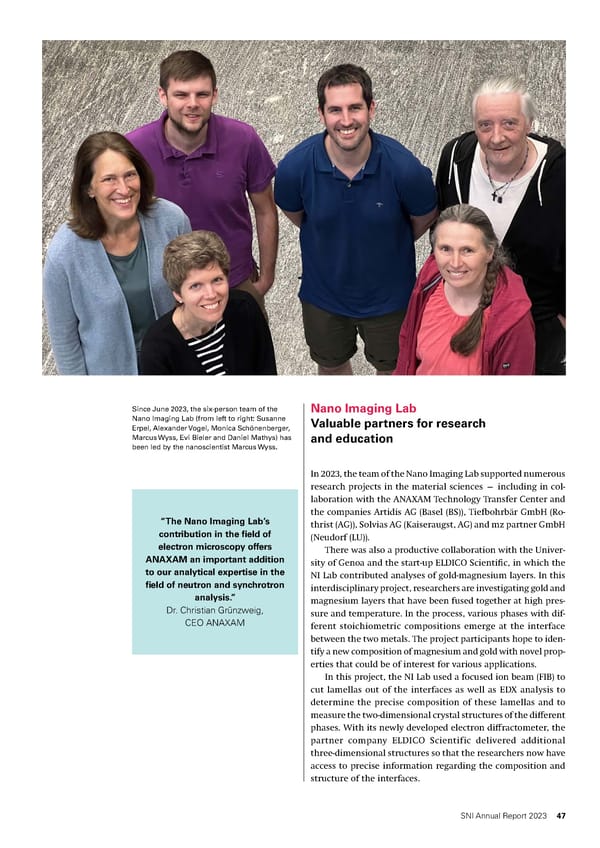
Electron microscope image of a lamella cut from In another collaboration, in this case with the group led by the gold-magnesium boundary layer. The contrast Professor Richard Warburton of the Department of Physics at difference reveals areas with different stoichio- the University of Basel, the NI Lab assisted with analyses of metric compositions of gold and magnesium. The researchers captured electron diffraction patterns quantum dots as a source of individual photons and created an in different regions. (Image: Nano Imaging Lab, interface between the emitted photons and stationary spin SNI, University of Basel) memories. In a recently published study, in which the research- ers succeeded in extending the coherence of an electron spin in a quantum dot for over half a microsecond for the 昀椀rst time, the NI Lab assisted the physicists with microscopic examina- tions of the quantum dots. The NI Lab has played an active role in trinational research projects relating to viticulture for many years — and the year 2023 saw the launch of the WiVitis project, which is approved for a period of three years and seeks to preserve and promote sustainable viticulture. Research groups from Germany, France and Switzerland are exploring how to deal with pests, climate change, and the resulting extreme weather events. The NI Lab’s key contribution to the project are scanning electron micro- scope images of shock-frozen grape vines, as these analyses are an ideal way of visualizing plant structures without causing damage and therefore allow the research teams to obtain valu- able information on the plants’ state of health. As well as assisting with numerous research projects, the sta昀昀 of the NI Lab also carry out research of their own. This allows them to expand the range of services available to cus- tomers in the future. For example, having incorporated a gas injection system onto one of the electron microscopes, the NI Lab team is now able to apply gold to various surfaces. In one 48 SNI Annual Report 2023
project, the NI Lab sta昀昀 assisted an SNI doctoral student at In another signi昀椀cant new purchase, the NF Lab acquired a metal the Biozentrum by fabricating gold tips on cantilever probes evaporator — a device that can be used to vaporize various met- to which proteins bind and can then be analyzed. Likewise, als and then oxidize them under controlled conditions, allowing there are also plans for the fabrication and characterization the production of extremely thin metallic and oxide layers with of electrically conductive nanoscale gold contacts that are no defects. This capability is primarily required by researchers suitable for wide-ranging applications. for the production of Josephson junctions, in which a non-su- perconducting material is sandwiched between two supercon- ducting layers. In November 2023 Xavier Wildermuth and Juri Herzog joined the Nano Fab- rication Lab team. From left to right: Gerard Gadea, Arnold Lücke, Juri Her- zog and Xavier Wildermuth. The two devices are located in the new, second clean room, which forms part of the Clean Room Facility Basel (CRFB). This will considerably expand the services available to customers of the NF Lab. Currently, the SNI is renting the new clean room in the building of the Department of Biosystems Science and En- gineering of ETH Zurich in Basel, whose construction was com- pleted in 2023. Scanning electron microscope images from shock-frozen vine leaves infect- Until now, the main users of the NF Lab’s facilities came ed with downy mildew and powdery mildew. from the Department of Physics at the University of Basel and (Images: Nano Imaging Lab, SNI, University of Basel) the start-up Qnami, which emerged as part of the SNI network. With the team now numbering four people and since the ex- pansion of the clean room capacities, the services of the NF Lab Nano Fabrication Lab will also be available to further academic and industrial cus- tomers in the future. Specialists in tiny structures In 2023, the team of the Nano Fabrication Lab continued in its e昀昀orts to pool the equipment of various working groups at the “The NF Lab is the working horse of our research: Department of Physics, to improve safety and e昀케ciency for users, It is where we fabricate our nanoscale devices on and to digitalize the laboratories that form part of the NF Lab. which we explore quantum physics. We are happy In addition, the NF Lab acquired new equipment, including about the effort of the team to make the fabrication of an electron beam lithography system. The sta昀昀 are still working samples proceed more smoothly and safely.” on installing the device, but it will soon be available for re- Prof. Andrea Hofmann searchers to fabricate structures measuring less than 10 nano- Department of Physics, University of Basel meters. Above all, the new machine will be used by customers from the 昀椀eld of quantum computing. SNI Annual Report 2023 49
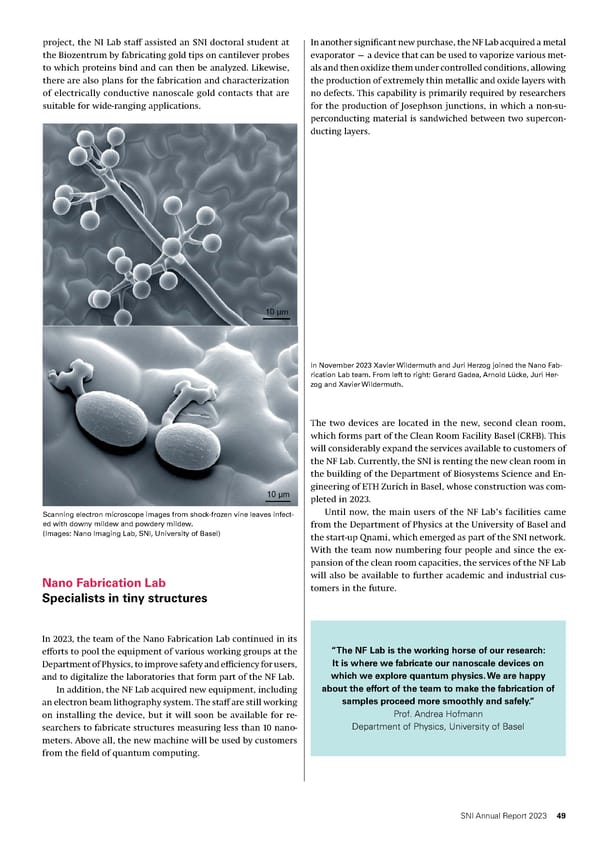
Education The newly acquired metal evaporator is located Joint activities in the new clean room, which the SNI has rented in the new building of the Department of Biosys- tems Science and Engineering of ETH Zurich in Basel. The two groups that make up the Nano Technology Center are also involved in teaching and public relations. In 2023, the two group leaders, Dr. Gerard Gadea and Dr. Marcus Wyss, o昀昀ered their 昀椀rst lecture course for bachelor’s students of nanosciences and physics. Students on the course “For me, working on the scanning electron microscope receive an introduction to the subject matter as well as an was a highlight of my Matura thesis. “ excellent overview of the practical work relating to electron Tim Zimmerli on the support from Evi Bieler and Monica and scanning probe microscopy as well as micro and nanofa- Schönenberger from the Nano Imaging Lab brication, thereby complementing their theoretical knowledge. Interns and visitors were welcomed to both the NF Lab and the NI Lab in 2023. By taking part in tours and interactive vi- sitor programs, they gained an insight into various activities relating to the imaging of the micro and nanoworld as well as various techniques for producing tiny structures. In 2023, the Nano Imaging Lab not only welcomed school classes but also supported 昀椀ve high-school students who nee- ded scanning electron microscope (SEM) analyses and images for their Matura projects. Providing this kind of support is very time-consuming but represents an investment in the future. After all, a broader understanding of the micro and nanoworld drives greater acceptance of nanosciences and nanotechnology. 50 SNI Annual Report 2023
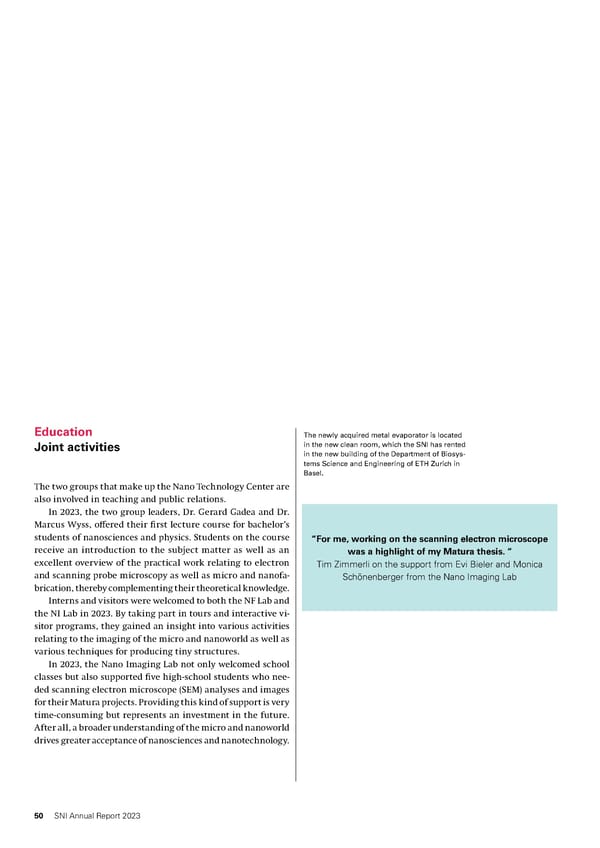
Gerard Gadea and Arnold Lücke testing the new electron beam lithography system. SNI Annual Report 2023 51
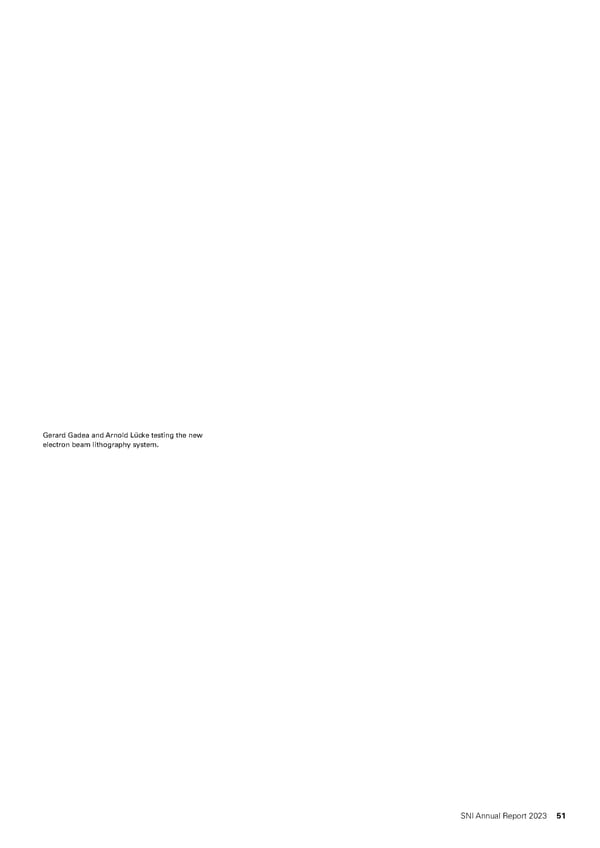
52 SNI Annual Report 2023
Tiny and beautiful Once a year, the SNI invites members of the network to submit the most beautiful images they’ve obtained from the nano and microworld for a chance of winning the Nano Image Award. The SNI team uses these “works of art,” which can only be seen using microscopes, to encourage an interest in the nanoworld. One of the winning images in 2023 was that of an X-ray condenser viewed under an optical microscope. The condenser’s complex geometry diffracts visible light and reveals a spectrum of brilliant colors, with each hue representing a speci昀椀c wavelength. With a diameter of 2 mm and lines with a width of down to 50 nm, the device was developed by researchers at PSI for an X-ray microscope at the Hereon research center in Germany. (Image: Peng Qi, Joan Vila-Comamala, Di Qu, Paul Scherrer Institute) SNI Annual Report 2023 53
Network: Collaboration across bound- aries between disciplines and institutions What makes the SNI so special is its interdisciplinary network, which includes researchers from various departments of the University of Basel (Biomedicine, Chemistry, Physics, Pharmaceutical Sciences, Environmental Sciences, and the Biozentrum), as well as members of research groups at the Schools of Life Sciences and Engineering at the University of Applied Sciences and Arts Northwestern Switzerland (FHNW) in Muttenz and Windisch, the Paul Scherrer Institute PSI, the Department of Biosystems Science and Engineering at the Federal Institute of Technology (ETH) Zurich in Basel (D-BSSE), the CSEM (Centre Suisse d’Electronique et de Microtechnique) in Allschwil, and the technology transfer centers ANAXAM and Swiss PIC. The wider network also includes both the Hightech Zentrum Aargau in Brugg and Basel Area Business & Innovation, which work to promote knowl - edge and technology transfer. 54 SNI Annual Report 2023
Essential for collaboration Exchange of ideas at the Annual Event reer category. As a physicist, Zardo received the award for her and Nano-Tech Apéro contributions to the methodology of characterizing nanoscale materials and the consequent discovery of their new functional properties. Regular events are essential for researchers from di昀昀erent re- Professor Christoph Gerber received the Albert Einstein search institutions to develop new ideas for projects and col- World Award of Science 2023. He was awarded this prize by the laborate e昀昀ectively. Each year since the SNI was founded, its World Cultural Council in recognition of the fundamental na- management has therefore organized the Annual Event for all ture and broad applicability of his research in nanoscale science. members of the network. In 2023, the event was held in the Professor Dominik Zumbühl was elected as an American Canton of Aargau for the 昀椀rst time, speci昀椀cally at Lake Hallwil. Physical Society Fellow in 2023 in recognition of his quantum Whereas all researchers from the network can present their transport experiments in semiconductor nanostructures at low work at the Annual Event, the focus at the annual Nano-Tech temperature, which sought to investigate coherence, spins and Apéro is on applied research. In 2023, this event was held at spin-orbit coupling. Switzerland Innovation Park Basel Area Allschwil. In addition Professor Marek Basler from the Biozentrum of the Univer- to the fascinating talks, visitors also enjoyed guided tours of sity of Basel was elected as a member of the prestigious Euro- ELDICO Scienti昀椀c, a start-up that developed within the SNI net- pean Molecular Biology Organization (EMBO). work, and of the neighboring Swiss Tropical and Public Health Professor Jonathan de Roo was awarded an SNSF Starting Institute (Swiss TPH). Grant in 2023 to support his research into recyclable sponges Video of Annual Event: https://youtu.be/f4HHrbnXw88 with programmable structures made from metal-oxo clusters. Dr. Markus Dürrenberger, the former head of the Nano Im- aging Lab, was granted honorary membership of the SNI for his outstanding services to microscopy. Further information: https://bit.ly/3Oew16m Ilaria Zardo, Christoph Gerber, Dominik Zumbühl, Marek Basler, Jonathan de Roo and Markus Dürrenberger are among the researchers from the SNI network who were honored in 2023. Fit for the future SNI events provide researchers from different institutions and disciplines Developing a strategy with an opportunity to exchange experiences and develop new ideas for projects. In 2023, the SNI team worked on developing a strategy for the Excellent next 10 years. As well as the SNI management, this process involved experts from the SNI network and from various Euro- Prizes and awards for researchers pean nanocenters, as well as the members of the SNI Executive from the SNI network Committee. In spring 2024, the results of this process will be published in a strategy paper to serve as a guide for the SNI’s future de- In 2023, prizes were awarded to numerous researchers from velopment. Key topics include focus areas, collaboration, ad- the SNI network. aptation and impact. Among them was the head of the Nano Technology Center, Professor Ilaria Zardo, who received the Emmy Noether Dis- tinction from the European Physical Society (EPS) in the mid-ca- SNI Annual Report 2023 55
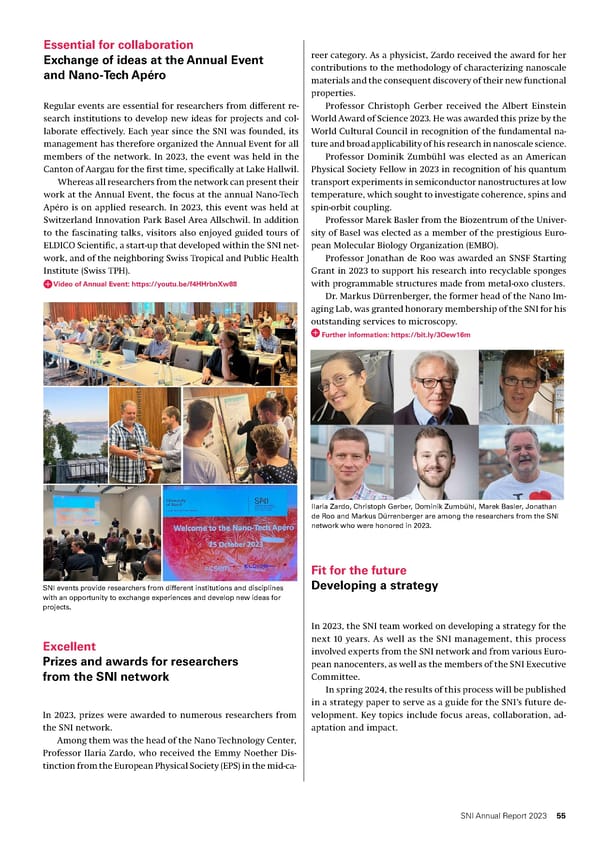
Communication and outreach: Sharing our fascination with the natural sciences Many of the research topics that play a role within the SNI are com- plex and not always easy to understand. The challenge for the com- munication and outreach team of the SNI is therefore to provide in- formation on the nanosciences, nanotechnology and the work of the SNI in a clearly comprehensible and attractive form for various target groups. Events involving personal interaction are also vital, as are print materials and the dissemination of news via social media. In 2023, the SNI team took part in established events such as the TecDays, visits by and to school classes, and the Science Days at Europa-Park Rust (Germany). In addition, however, they also tested new formats with a view to reaching people who previously had lit - tle contact with the natural sciences. Social media and the website, which was redesigned in 2023, are also playing an increasingly signi昀椀cant role in the SNI’s communica- tions. Key topics include news on research projects, awards, portraits and events. These themes are often brought to life in short videos that are produced in house. At the end of 2023, the SNI had more than 5,500 followers – including individuals and organizations – across its LinkedIn, X, Instagram and YouTube channels . 56 SNI Annual Report 2023
Always something new SNI team tests new formats Some of the events in which the SNI participates have formed part of the outreach team’s program for many years. For exam- ple, visits to and by school classes, as well as the TecDays orga- nized by SATW, are well-established features and provide an opportunity to show pupils the exciting challenges that nano- science researchers are facing with the help of a clear, interac- tive program. Likewise, the annual Science Days at Europa Park Rust also form part of the SNI’s “standard program,” bringing As part of “MINT on the move,” passengers could take part in science exper- together children and adults who are interested in experiments iments and craft projects in collaboration with the SNI staff. and learning about the natural sciences in their spare time. In 2023, however, the SNI also tried out two activities with new formats in order to address target groups that we have not been reached in the past. For one of these activities, two mem- bers of SNI sta昀昀 were on board of several Treno Gottardo rail services operated by SOB. Setting themselves up in the family area of the trains, they o昀昀ered passengers the chance to take part in experiments and craft projects all about light as part of a project entitled “MINT on the move.” In another new format, students from Oberrhein high school in Weil am Rhein (Ger- many) were asked to draw details of equipment in laboratories at the Department of Physics as part of the “Change of Perspec- tive” project. These drawings were then presented — along with explanations — in an exhibition both at the Department of Physics and at the school. At the Rüeblimärt in Aarau, numerous visitors expressed an interest in the At the start of 2023, the newly designed SNI website also SNI’s activities. went live, providing extensive information on the various ac- tivities of the SNI as well as current news and events. Posts on the SNI’s various social media channels generally link to longer articles on the site. Further information: YouTube channel: https://bit.ly/3u9XLjv LinkedIn: https://bit.ly/3rbYP4s X: https://twitter.com/SNIunibas SNI website: www.nanoscience.ch Experiments to perform at home: https://bit.ly/42N6zer Video series on women in the nanosciences: https://bit.ly/48NNHya SNI INSight seeks to present An animated version of the online magazine news about the SNI in a more attractive form for readers. “The special thing about the experiments on the train was that people really had time to listen to us and learn about the nanosciences.” Dr. Kerstin Beyer-Hans, outreach manager at the SNI and initiator of the project “MINT on the move” In the “Change of Perspective” project, our pupils bene昀椀ted from links with academia and learned about the potential for a fascinating interface between the worlds of art and science. Dr. Tanja Reinhardt-Albiez Principal Oberrhein high school, Weil am Rhein A video series on women in the nanosciences features examples of various nanoscience careers. SNI Annual Report 2023 57
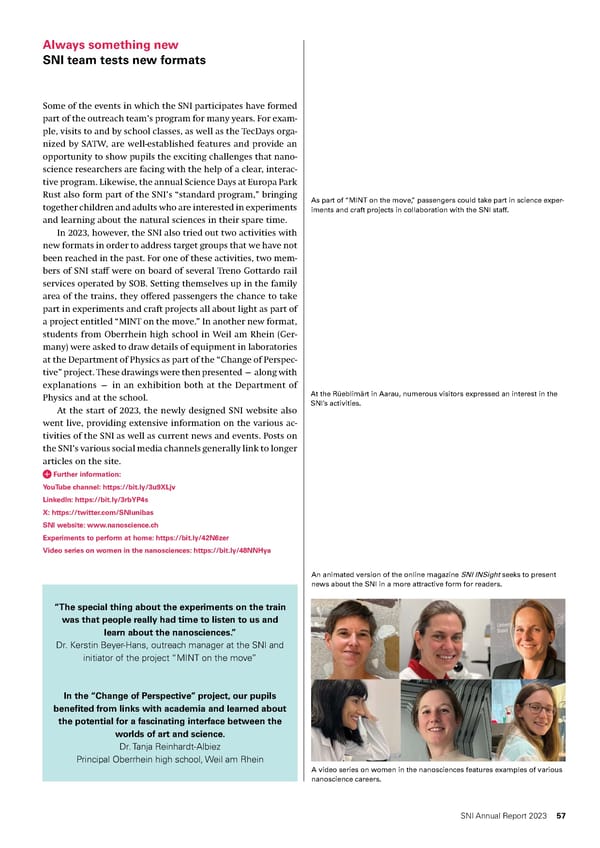
Financial report The Swiss Nanoscience Institute (SNI) was founded by the Uni- A focus on knowledge and technology transfer versity of Basel and the Canton of Aargau in 2006. Then, as now, With the Nano-Argovia program, which has existed since the the goal was to establish a center of excellence for the nano- Swiss Nanoscience Institute was founded, the SNI supports sciences and nanotechnology in Northwestern Switzerland, to knowledge and technology transfer to industry. This program advance nanoscience research, and to support knowledge and sees industrial companies from Northwestern Switzerland work technology transfer to industry, as well as to deliver an excel- with at least two academic partners from the SNI network to lent education for early career researchers. explore novel lines of applied research at an early stage. In 2023, the SNI launched nine new Nano-Argovia projects with total It all starts with basic research funding of some CHF 1.4 million. Project partners contributed As innovations are founded on a fundamental understanding almost CHF 0.8 million via public research funding instruments of phenomena in the nanoworld, the SNI invests in wide-rang- (e.g. Innosuisse, Swiss National Science Foundation and EU fund- ing research into questions of basic science. On the one hand, ing) and funding from the research institutions themselves. The this is achieved by funding the two Argovia Professors Rodrick industrial partners contributed around CHF 1.1 million to the Lim and Martino Poggio, both of whom have contributed to the various lines of research in the form of in-kind services. SNI’s excellent reputation with their research groups since the early years of the institute. Through their participation in na- Continued expansion of the Nano Technology Center tional and international collaborations, the two Argovia profes- In 2023, the SNI achieved further milestones in the expansion sors together received over CHF 1.9 million in funding for their of the Nano Technology Center, which is becoming increasingly research in 2023. The SNI also supports the work of Professor established as a service center of the SNI. The Nano Technology Patrick Maletinsky (University of Basel) as well as three titular Center includes the Nano Imaging Lab, which was founded in professors at the Paul Scherrer Institute: Thomas Jung, Michel 2016, and the Nano Fabrication Lab, which was founded in 2022. Kenzelmann and Frithjof Nolting. In total, the professors re- The two service units provide customers from industry and ceived funding of some CHF 1.7 million in 2023. academia with comprehensive services in the area of imaging Basic science is also the 昀椀eld of research pursued by most as well as in micro and nanofabrication. doctoral students at the SNI PhD School, which was founded in In 2023, the Nano Fabrication Lab received large new instru- 2012. The 40 doctoral students who formed part of the PhD ments that will play a key role in its micro and nanofabrication School in 2023 work at various institutions within the SNI net- services. This followed an investment of CHF 0.5 million in the work — but they all earn their doctorates from the Faculty of new equipment by the SNI. Such investments are only possible Science at the University of Basel. In total, the outgoings for the thanks to reserves, which also meant that necessary repairs PhD School ran to some CHF 2 million in 2023. could be carried out quickly on microscopes in the event of The following table shows the outgoings for 2023 by item of expenditure according to the 昀椀nancial report of the University of Basel of 26 February, 2024: Expenditure 2023 in CHF Univ. Basel Canton AG Total Management Personnel and operational costs 92’973 260’364 353’337 Overhead — 650‘000 650‘000 Infrastructure Infrastructure equipment 27’034 1’130’944 1’157’978 Know-how & Techtransfer Personnel and operational costs 23’980 136’481 160’461 Nano-Argovia projects — 1’370’119 1’370’119 Outreach & PR Personnel and operational costs 95’231 77’742 172’973 Support Professors Univ. Basel 569’664 1’064’013 1’633’677 PSI professors 53’366 53’366 Nano Curriculum Bachelor and master programs 293’846 236’494 530’340 Nano Technology Center Nano Imaging/Nano Fabrication 652’582 303’741 956’323 SNI PhD School Personnel and operational costs 802’779 1’204’399 2’007’178 Total expenditure 2023 in CHF 2’558’090 6’487’662 9’045’752 58 SNI Annual Report 2023
malfunctions. In total, the Nano Technology Center’s budget CHF 1.2 million in new infrastructure in 2023. ran to almost CHF 1 million in 2023. Other purchases with a Further investments in research infrastructure were planned view to equipping the Nano Technology Center for the future in 2023, but long delivery times mean they will not appear in were also approved in 2023, but long delivery times will mean the 昀椀nancial report until 2024. The SNI Executive Committee that they are not included in the cost accounting until 2024. approved further infrastructure investments of around CHF 1 million at its 昀椀rst meeting of 2024. This ensures that the SNI’s Study and outreach as further cornerstones of our work reserves are put to sensible use and will help to equip the SNI The SNI contributes over CHF 0.5 million to the interdisciplinary and associated research groups for the future. degree program in nanosciences at the University of Basel. In In the last line of the SNI’s annual statement, some CHF 5.6 2023, 56 bachelor’s and 26 master’s students took advantage of million are shown as “SNI assets per 31 December 2023, in CHF.” this educational program — the only one of its kind in Switzer- This balance does not take account of commitments already land — in which early career researchers receive a broad ground- made in previous years, including new equipment for the Nano ing in the natural sciences and are therefore ideally equipped Technology Center and investments in infrastructure for re- to work at the interfaces between di昀昀erent disciplines. search groups. In addition, there is always a proportion of fund- The work of the SNI team also includes raising awareness ing for Nano-Argovia projects that has not been spent yet. A of the degree program and informing the public about nano- signi昀椀cant part of this funding consists of reserves for ongoing sciences and the activities of the SNI in general. To this end, doctoral dissertation projects, as doctoral students at the SNI sta昀昀 take part in various events and establish their own formats PhD School are funded for a contract period of 48 months. for dialog with the general public. Increasing importance is also placed on publishing information about the SNI on social media. We would like to extend our sincere thanks to the Finance de- Events such as the Annual Event and the Nano-Tech Apéro pro- partment at the University of Basel for its valuable collaboration vide essential occasions for an internal exchange of ideas. Here, throughout the year and for its e昀케cient 昀椀nancial reporting. A SNI members have the opportunity to get to know one another, huge thanks also goes to the Cantons of Aargau, Basel-Stadt and discuss their research and generate new ideas. In total, the costs Baselland. Their ongoing commitment is what makes it possible for public relations and internal events come to less than CHF for the SNI to train excellent early career researchers, generate 0.2 million. new scienti昀椀c insights, and support companies with innovative projects as we work toward building a better future. Essential investments in the future Modern infrastructure is vital in order to remain competitive in the nanosciences and nanotechnology. Accumulated reserves allow the SNI to support infrastructure measures in research groups and at the Nano Technology Center. In addition to pro- curements in the service sector, the SNI also contributed CHF 0.5 million to the acquisition of a state-of-the-art electron mi- croscope at the Biozentrum. In total, the SNI invested almost The following table shows the income statement of SNI funds as of 31 December, 2023: SNI annual statement in CHF Univ. Basel Canton AG Total Grants 2’827’284 5‘140‘000 7’967’284 Investment income 16’009 1’068 17’077 Income 2’843’293 5’141’068 7’984’361 Expenditure 2’558’090 6’487’662 9’045’752 Annual balance 2023 285’204 (1’346’594) (1’061’390) SNI assets per 01/01/2023 1’704’344 4’923’761 6’628’105 Annual balance 285’204 (1’346’594) (1’061’390) SNI assets per 31/12/2023 in CHF 1’989’548 3’577’167 5’566’715 SNI Annual Report 2023 59
Organization Nano Fabrication Lab Dr. G. Gadea (Head) J. Herzog (since 01.11.2023) Argovia Board A. Lücke (昀椀nanced by Department of Physics) Regierungsrat A. Hürzeler, Head Department of Education, X. Wildermuth (since 01.11.2023) Culture and Sport, Canton of Aargau Prof. Dr. A. Schenker-Wicki, President University of Basel Prof. Dr. M. Poggio, Director SNI Prof. Dr. C. Bergamaschi, President FHNW Prof. Dr. G.-L. Bona, former Director Empa Dr. W. Riess, former IBM Department Head & Coordinator Binnig & Rohrer Nanotechnology Center Prof. Dr. C. Rüegg, Director Paul Scherrer Institute SNI Executive Committee Lists of members and Prof. Dr. M. Poggio, Director SNI (PhD School) projects 2023 Prof. Dr. P. Maletinsky, Vice Director (Nano-Argovia program) Prof. Dr. S. Hiller (Biozentrum, Rectorate/Faculty) Prof. Dr. J. Huwyler (Curriculum Nanoscience, Department of Pharmaceutical Sciences) Principal Investigators and associated members Prof. Dr. R. Y. H. Lim (Biozentrum) https://bit.ly/4c6kIYb Prof. Dr. K. Moselund (Paul Scherrer Institute) Prof. Dr. O. Tagit (University of Applied Sciences Northwestern PhD students Switzerland) https://bit.ly/4c2yzyM Prof. Dr. O. Wenger (Department of Chemistry) C. Wirth, General Manager SNI (HR, 昀椀nance, administration) SNI PhD School projects 2023 Prof. Dr. I. Zardo (Nano Technology Center and Department of https://bit.ly/3uZQOUU Physics) Nano-Argovia projects 2023 https://bit.ly/4bVfoa2 SNI Management Prof. Dr. M. Poggio, Director SNI C. Wirth, General Manager (HR, 昀椀nance, administration) Dr. A. Baumgartner (PhD School) Dr. A. Car (Curriculum Nanosciences) Further information Dr. K. Beyer-Hans (Communications, outreach) Dr. G. Gadea (Nano Fabrication Lab) S. Hüni (Communications, outreach) Dr. C. Möller (Communications, media contact, social media) If you would like to know more about the Swiss Nanoscience Dr. M. Wegmann (Outreach, communications, social media) Institute, please visit our website (www.nanoscience.ch) or fol- Dr. M. Wyss (Nano Imaging Lab) low us on LinkedIn, X, Instagram or YouTube. There we regularly post news from the network. Curriculum Nanosciences Scienti昀椀c supplement Dr. A. Car (Study coordinator) Scienti昀椀c reports from all the Nano-Argovia and SNI PhD School S. Chambers (Administration) projects from 2023 can be found on our website or by scanning the QR code. https://bit.ly/3TrNwTL Nano Imaging Lab Dr. M. Dürrenberger (Head until 31.05.2023) Dr. M. Wyss (Head since 01.06.2023, TEM, FIB-SEM) E. Bieler (SEM) S. Erpel (SEM, TEM) D. Mathys (FIB-SEM, Image coloring) Dr. M. Schönenberger (AFM, LSM) Dr. A. Vogel (TEM, FIB-SEM) 60 SNI Annual Report 2023
Title image: Microspheres Microspheres were prepared from styrene via emulsion polymerization by students in the prac- tical training in polymers at FHNW. The spheres (Ø approx. 0.25 µm) form hexagonally ordered assemblies when dried on the sample holder. The image was taken with an electron microscope. The spheres were originally white and the image was colored using Adobe Photoshop. (Image: V. Hollenstein, L. Martinez and S. Saxer, FHNW Mut- tenz) About this publication: Design concept: STUDIO NEO Text and layout: C. Möller and M. Poggio with support from PIs and PhD students Translations and proofreading: UNIWORKS (Erlangen, Germany) Images: If not referenced C. Möller © Swiss Nanoscience Institute, April 2024 SNI Annual Report 2023 61


Educating Talents since 1460. University of Basel Swiss Nanoscience Institute Scienti昀椀c supplement Petersplatz 1 University of Basel P.O. Box Klingelbergstrasse 82 4001 Basel 4056 Basel Switzerland Switzerland www.unibas.ch www.nanoscience.ch

